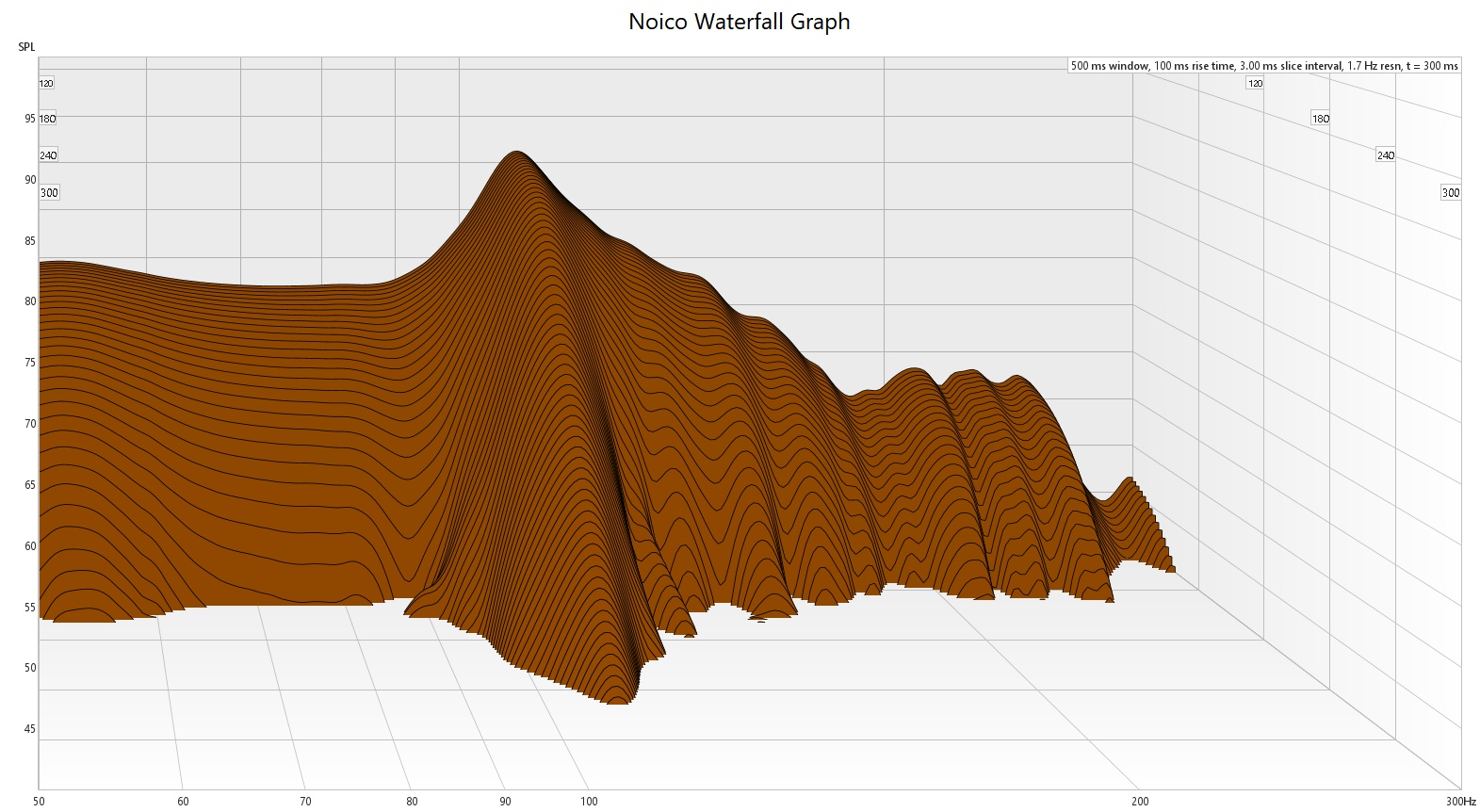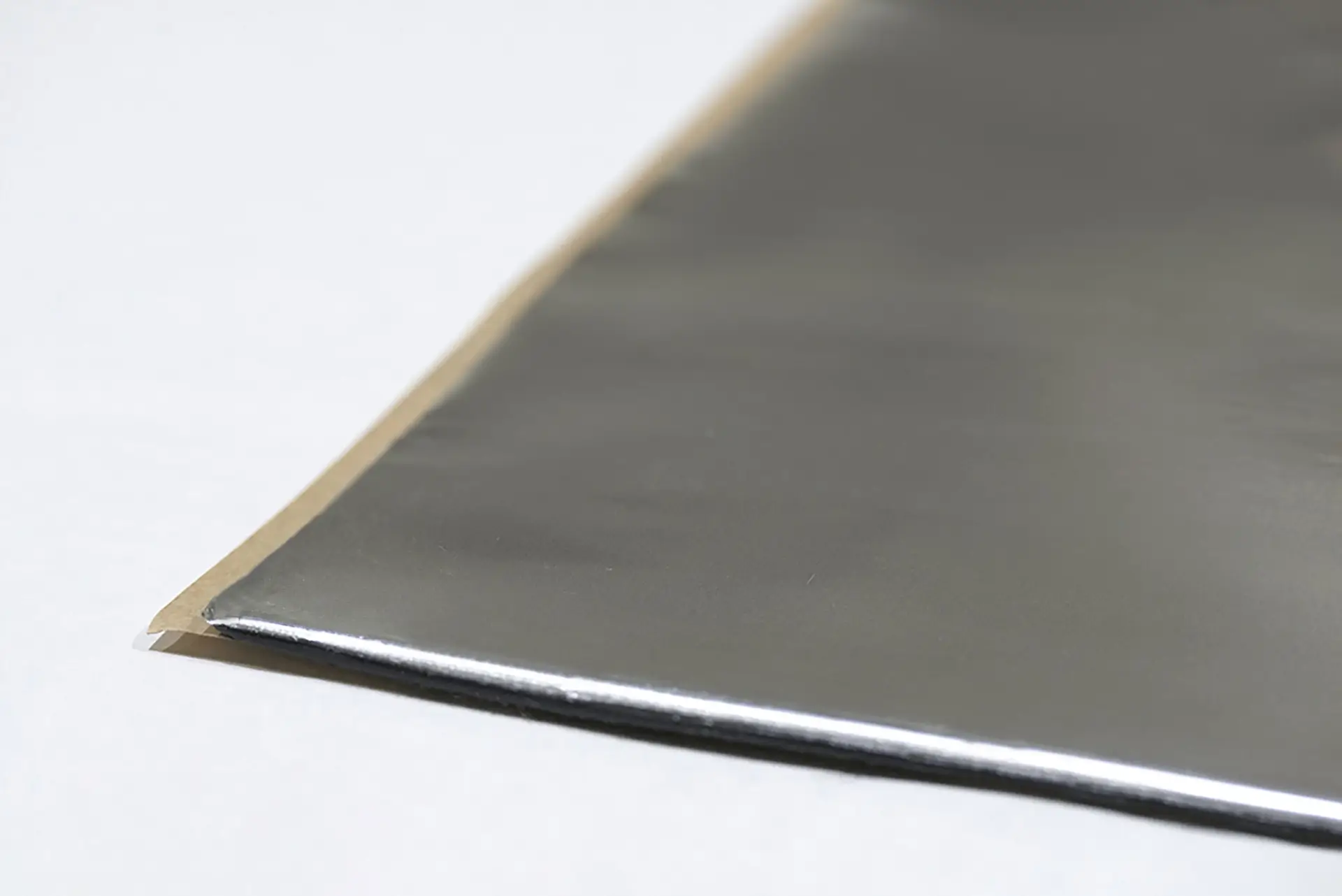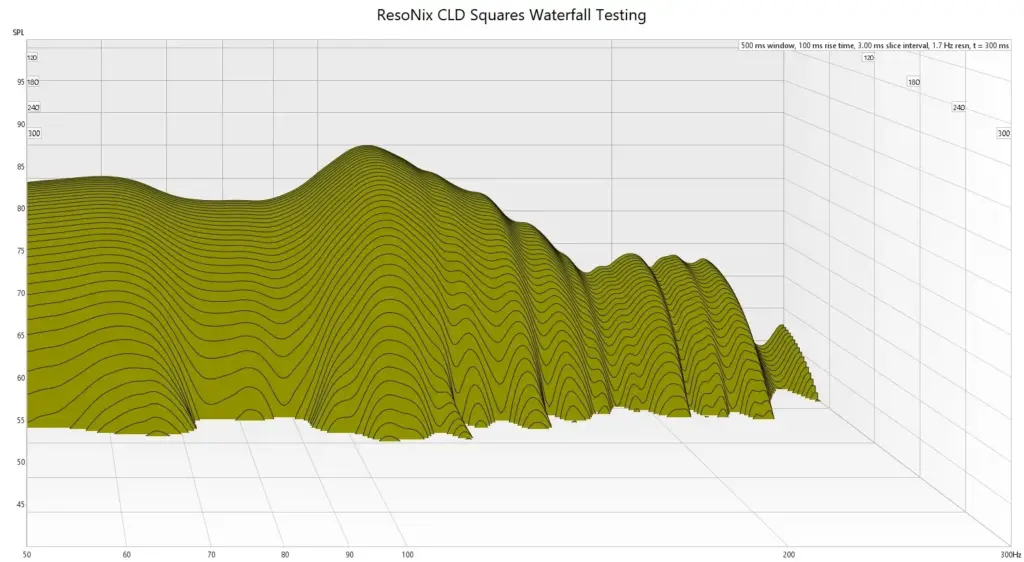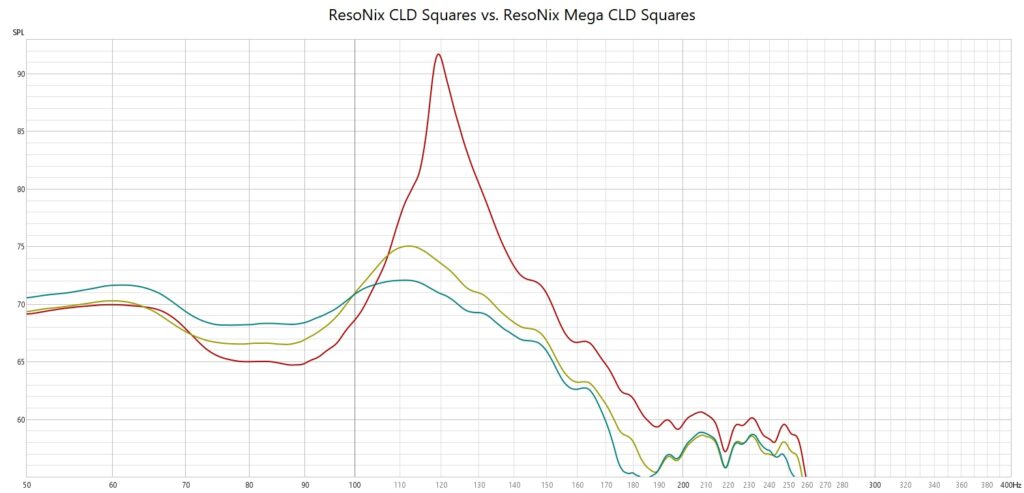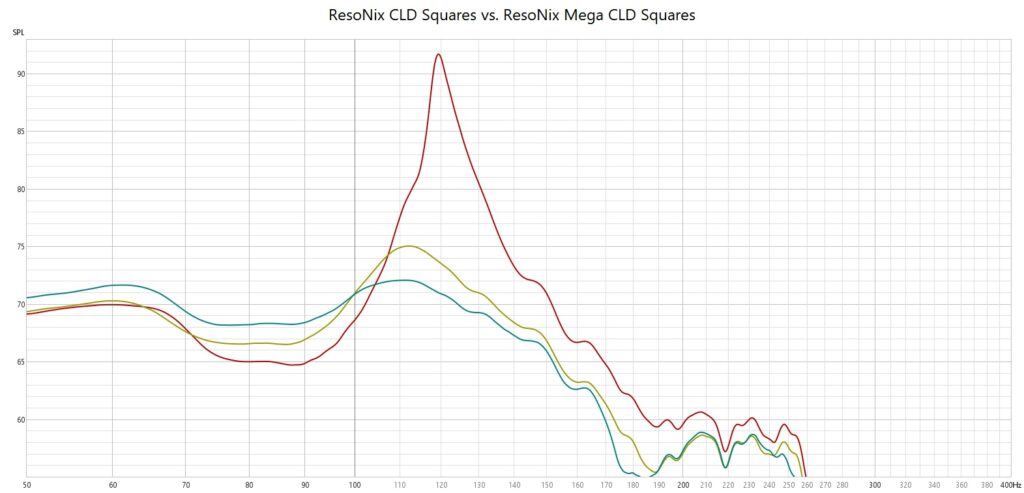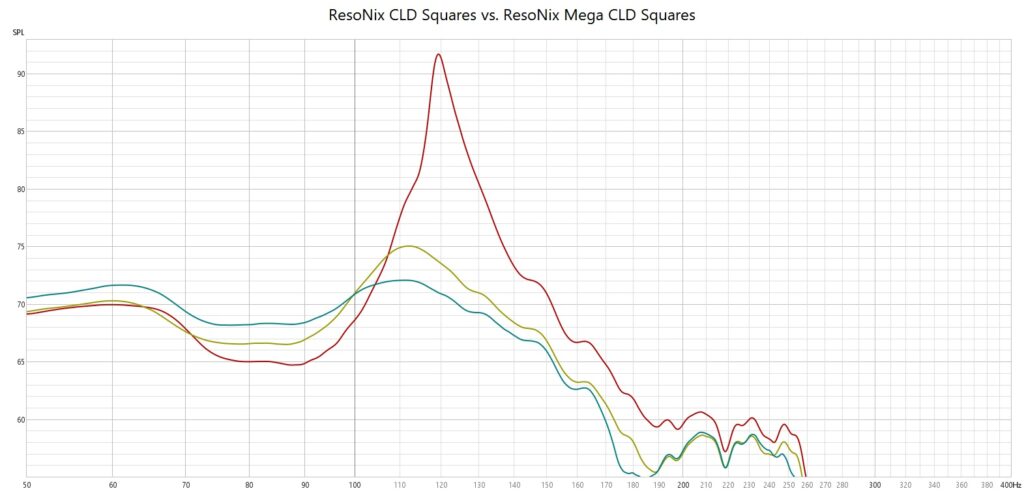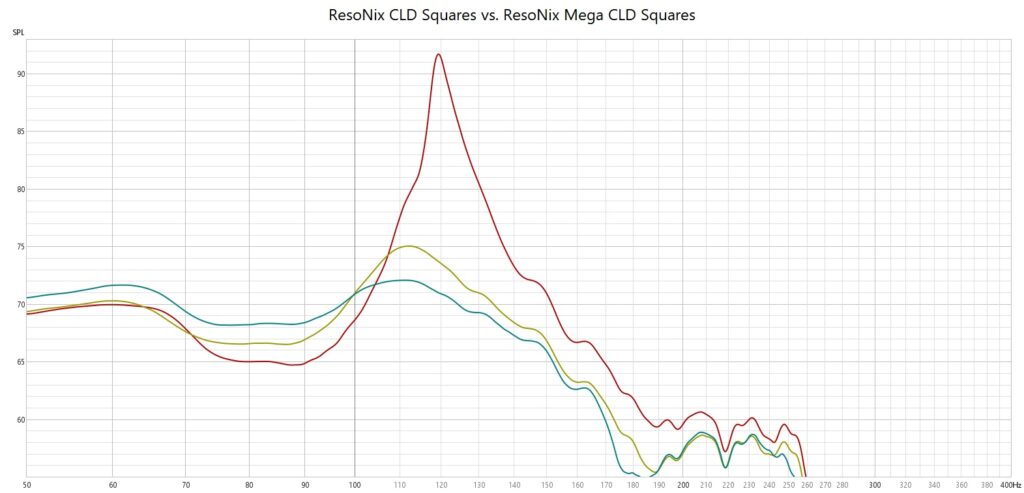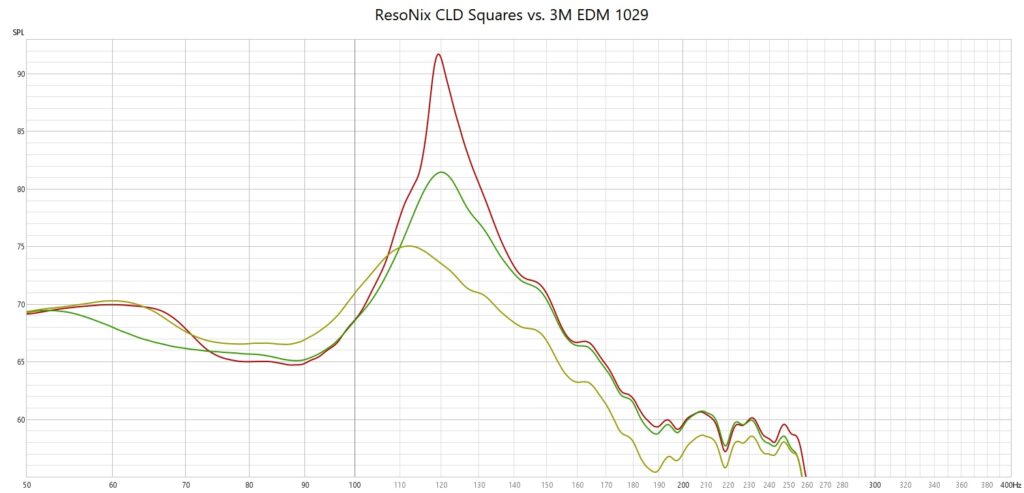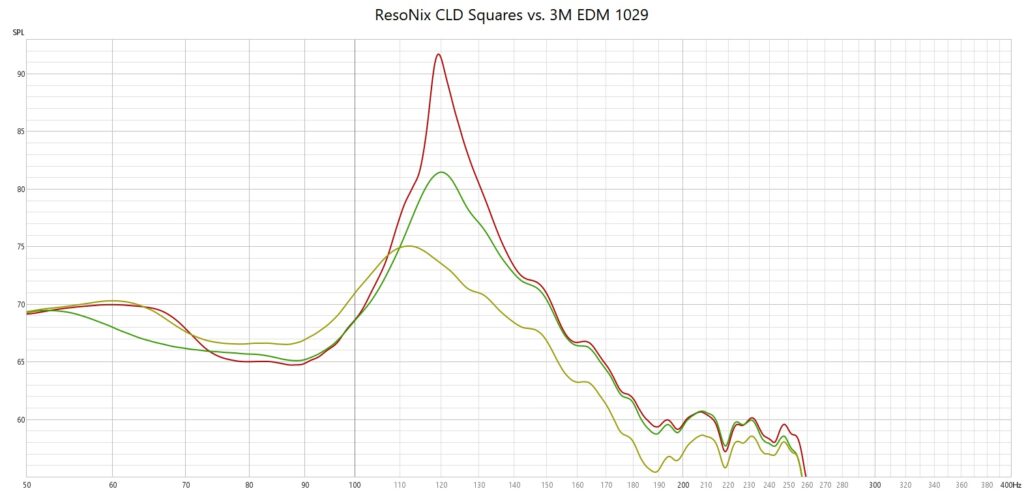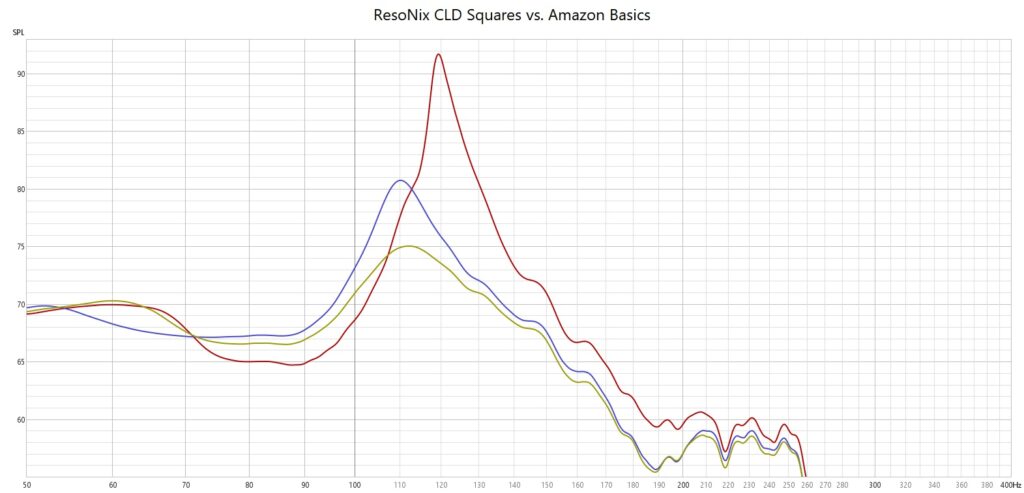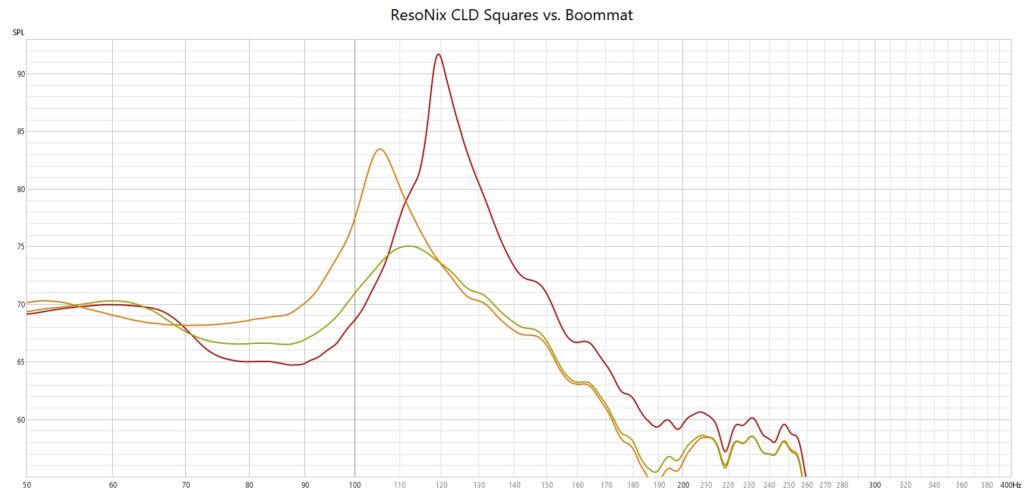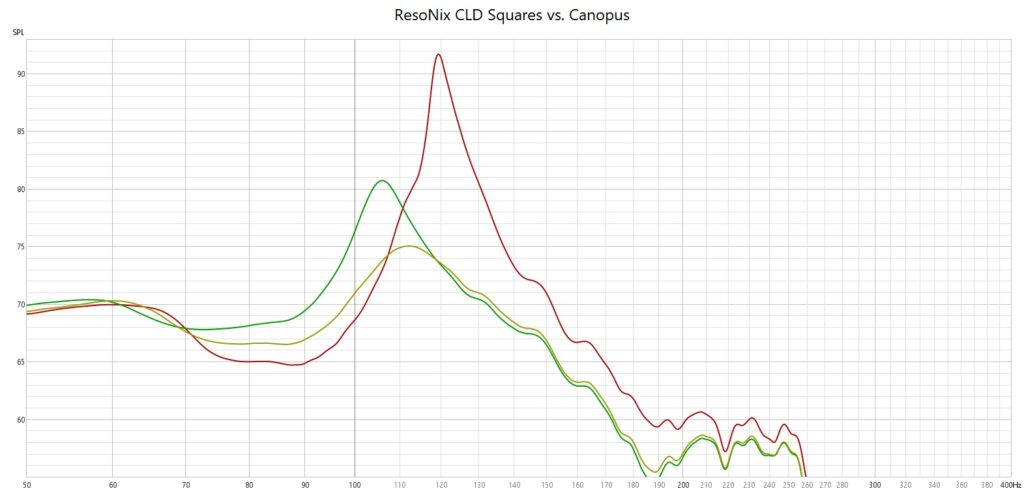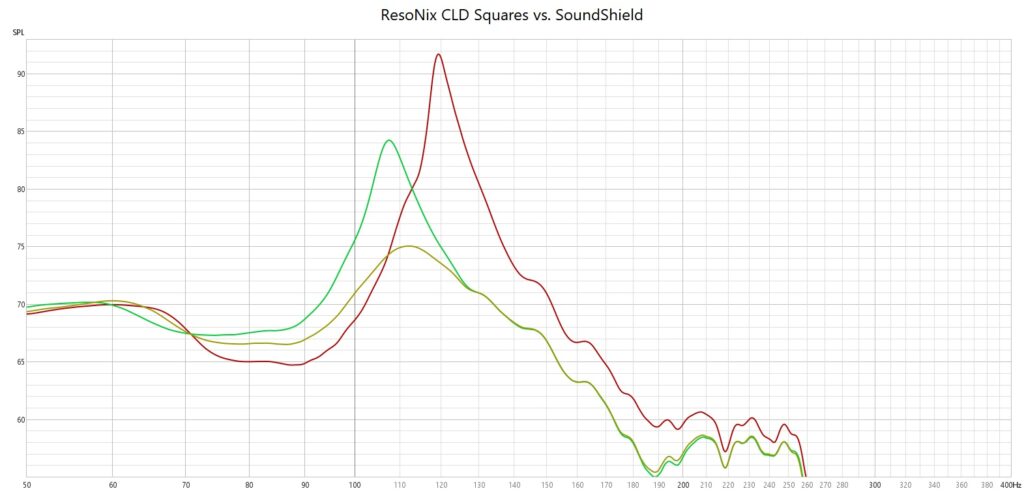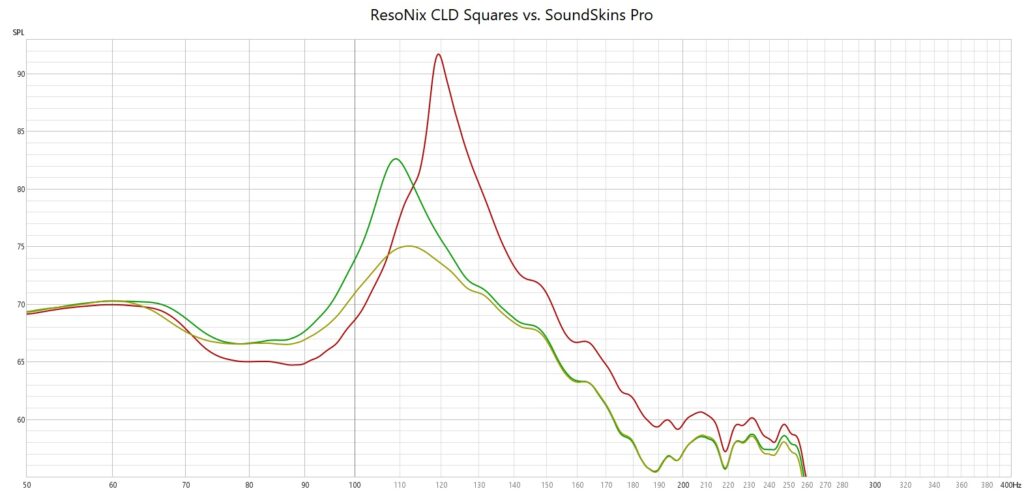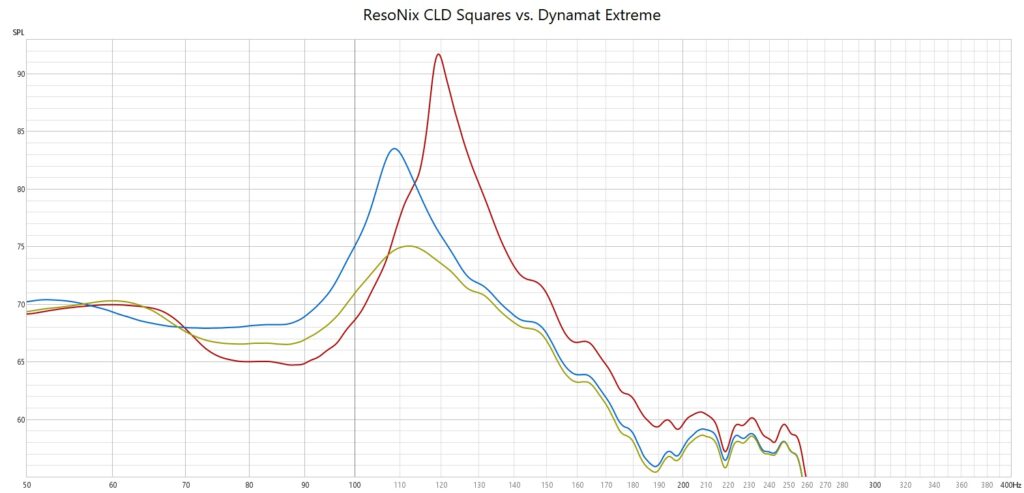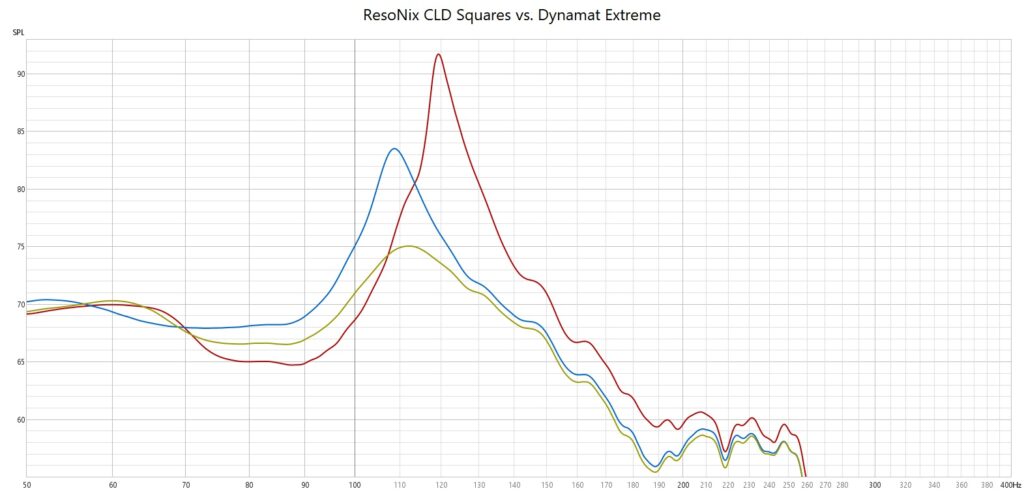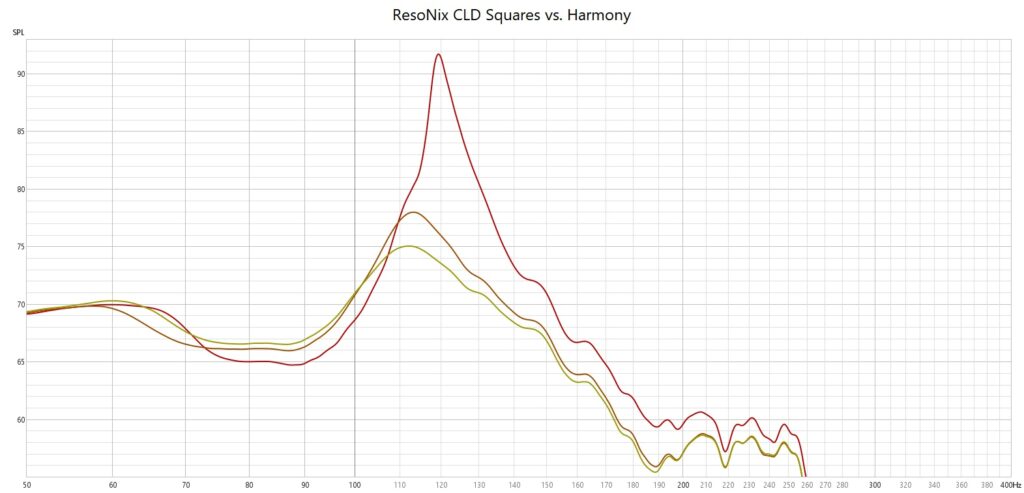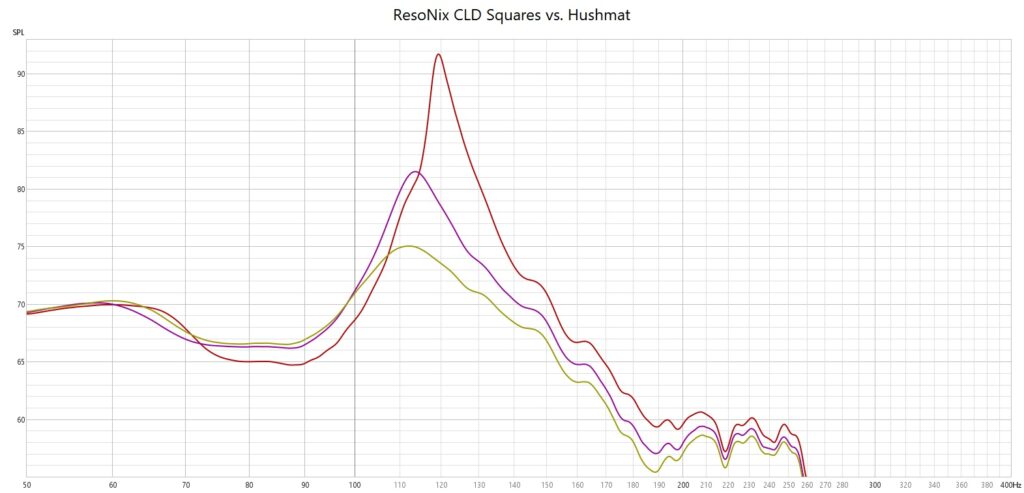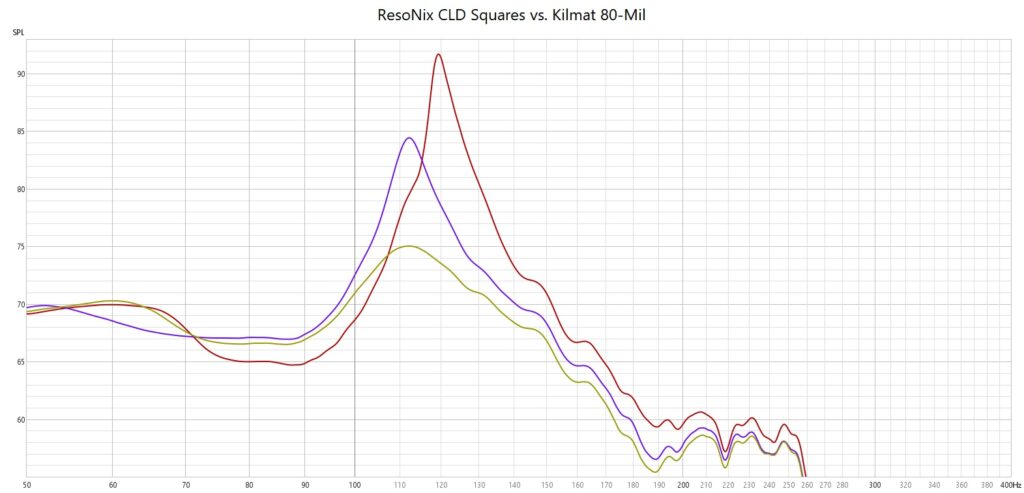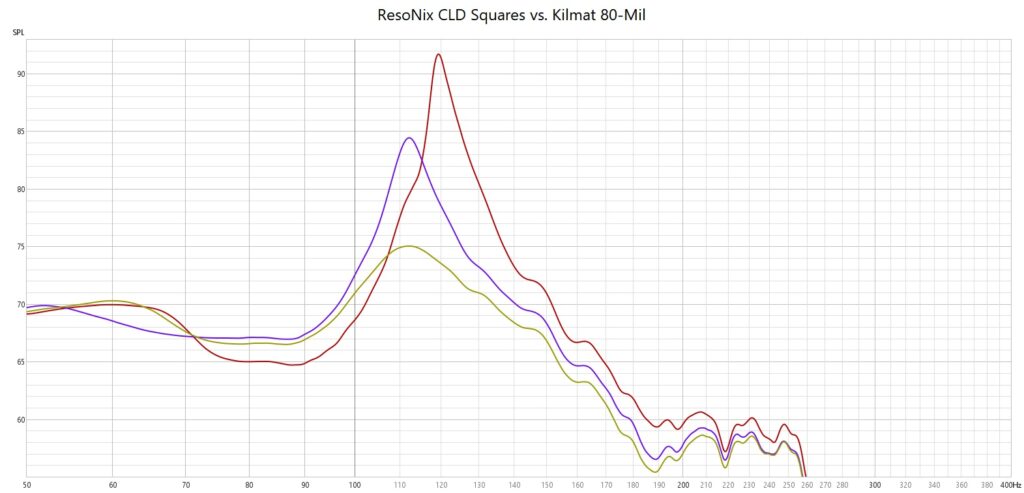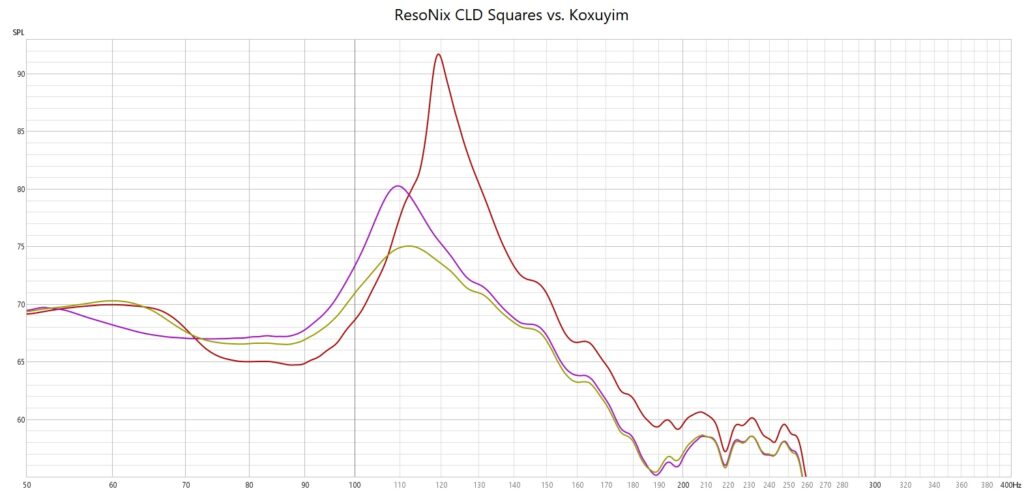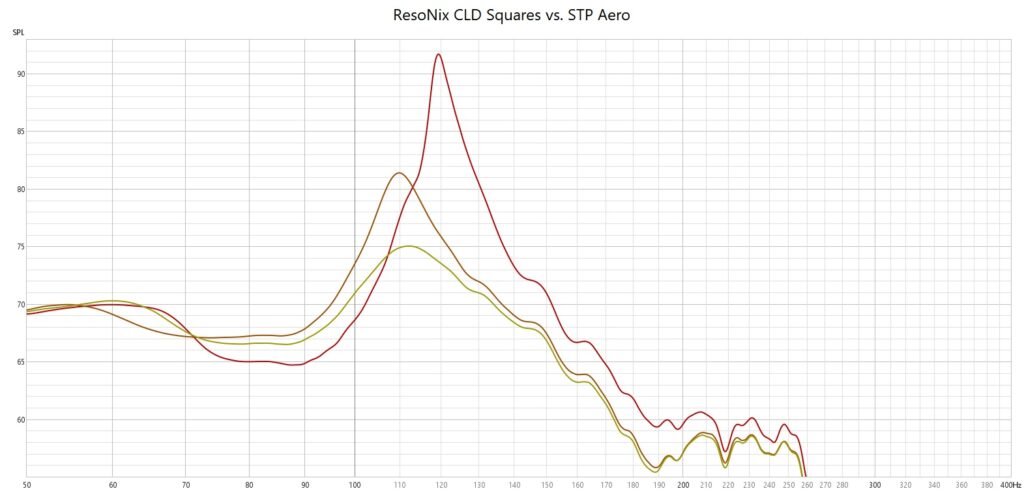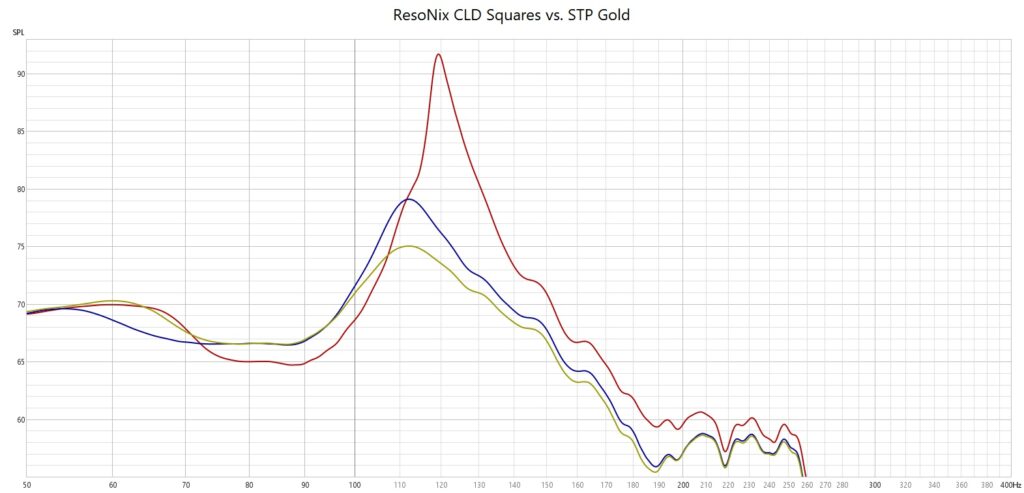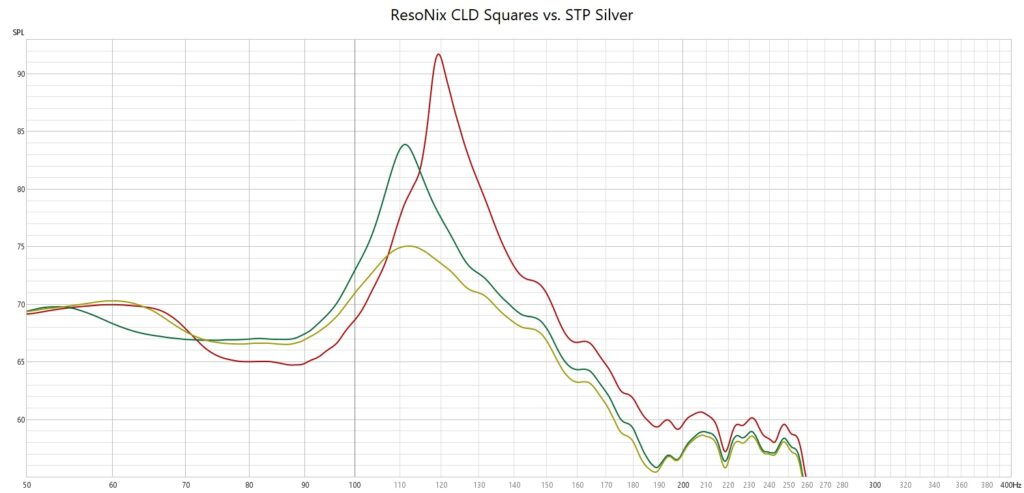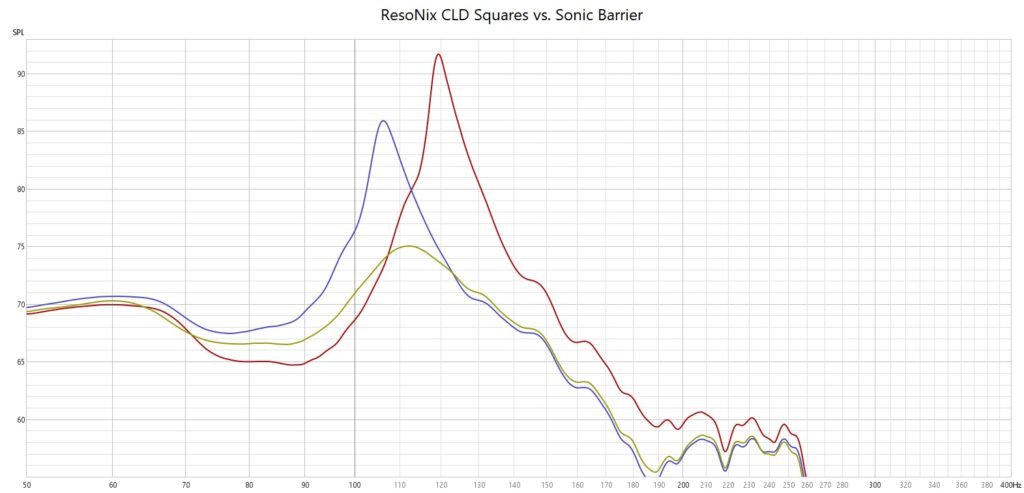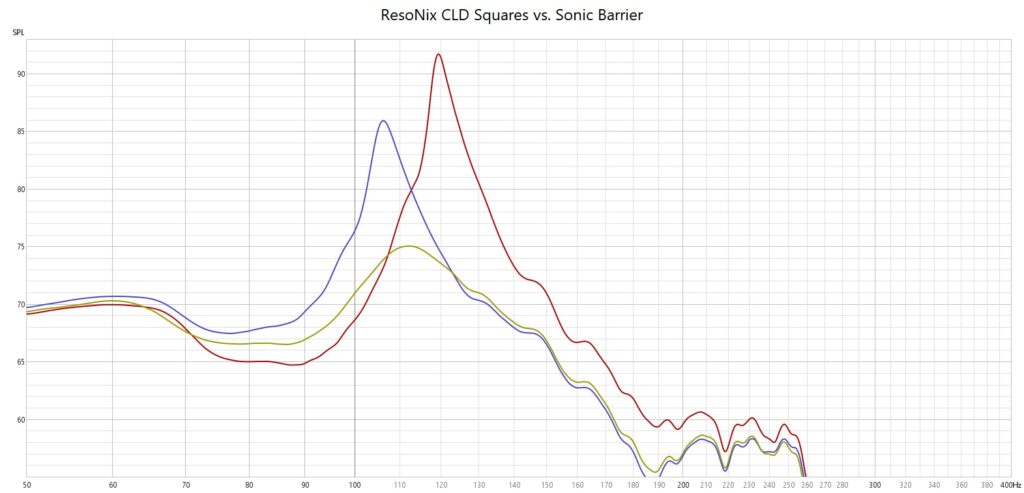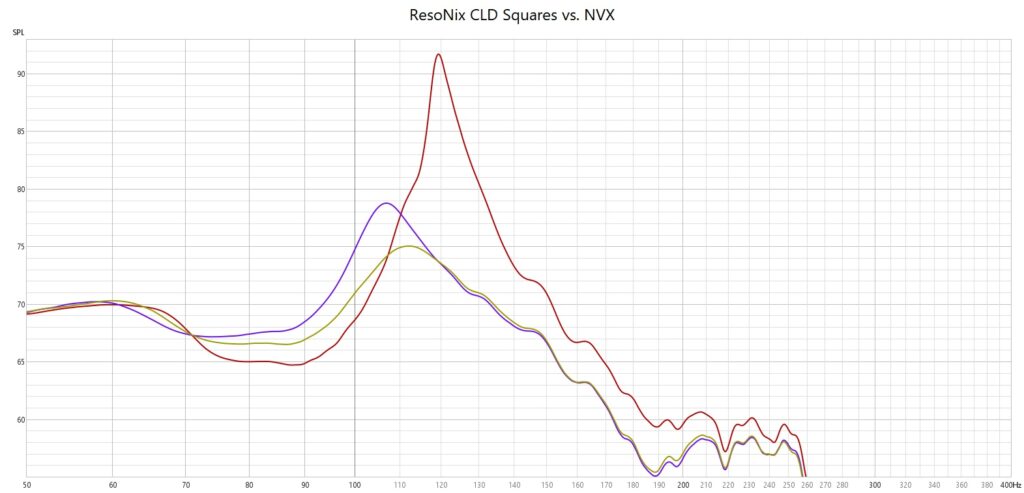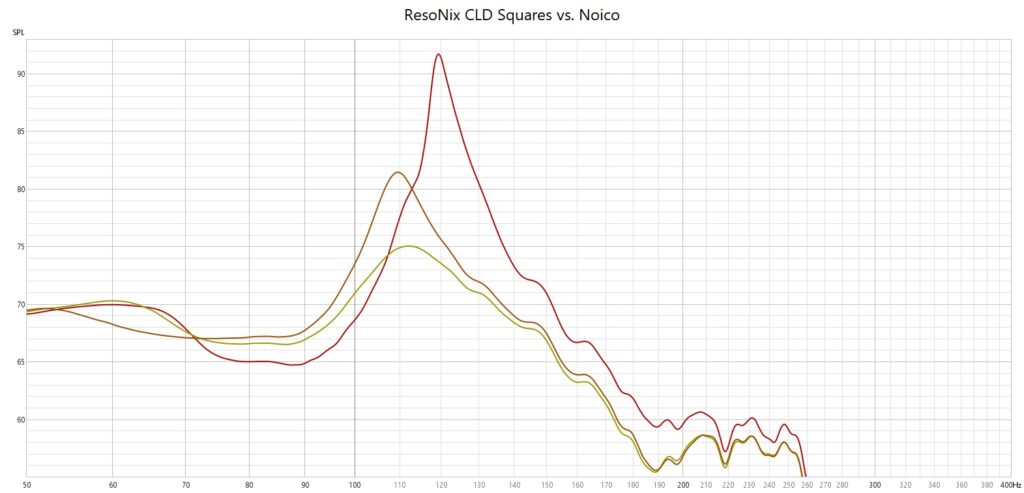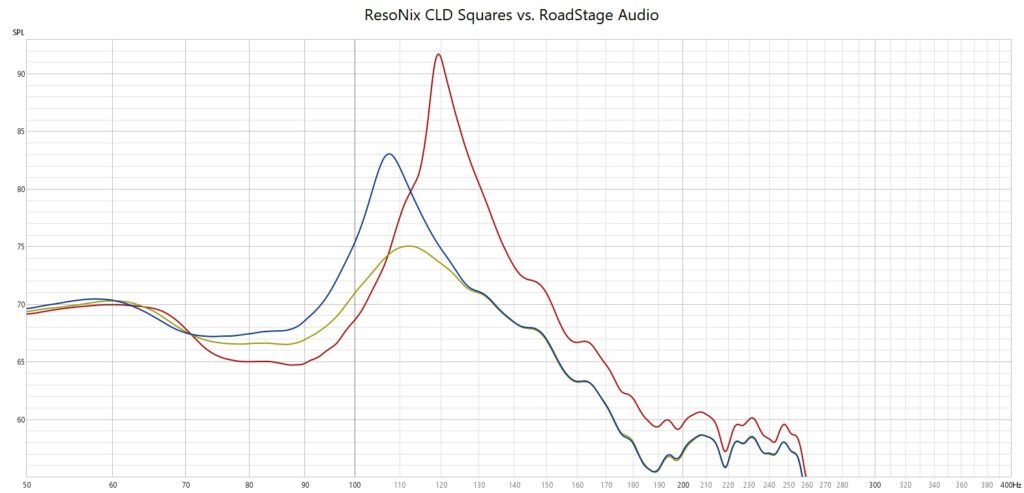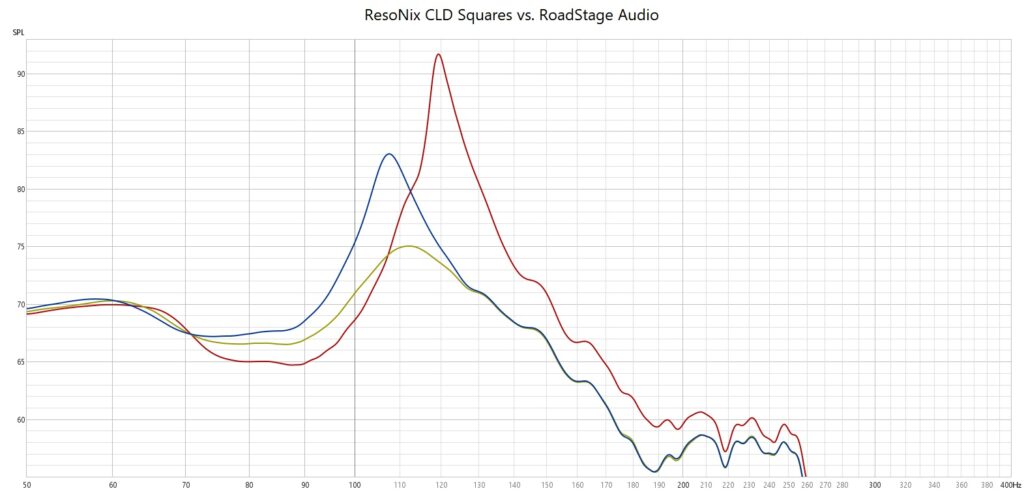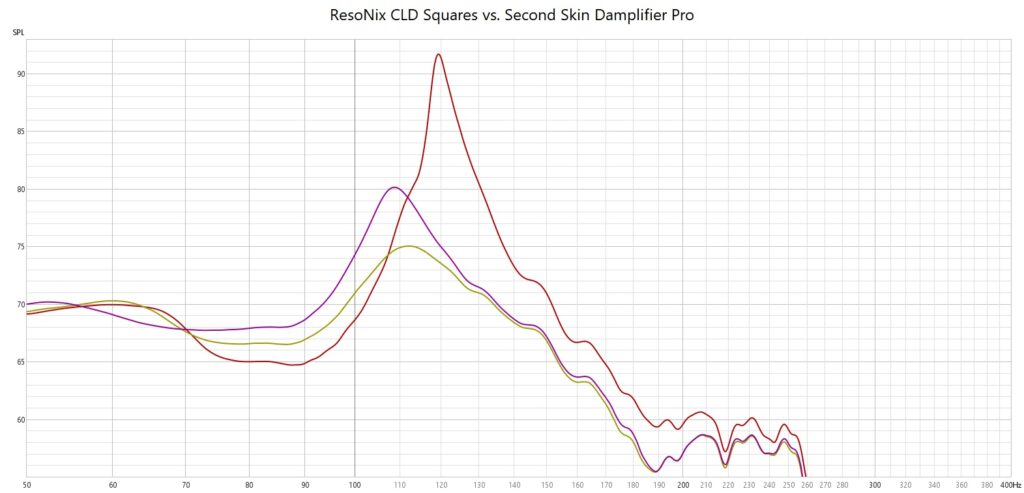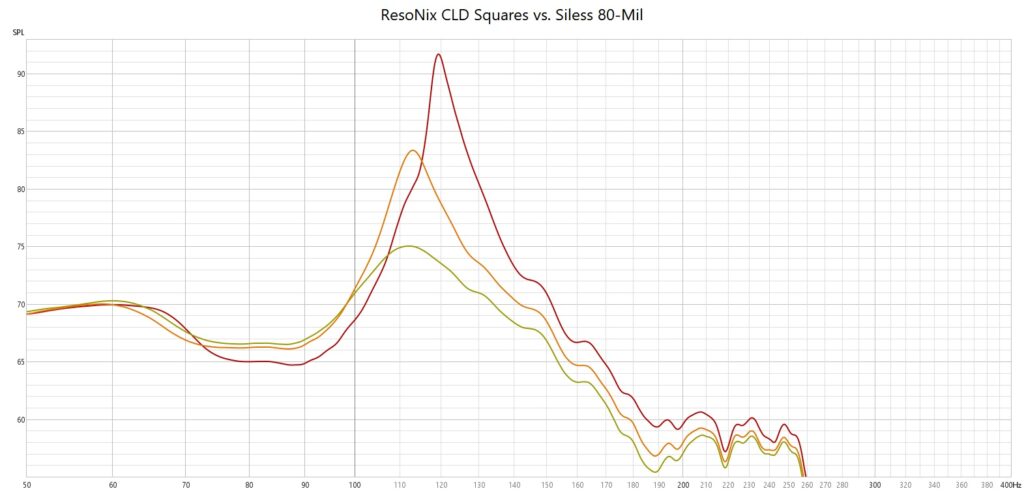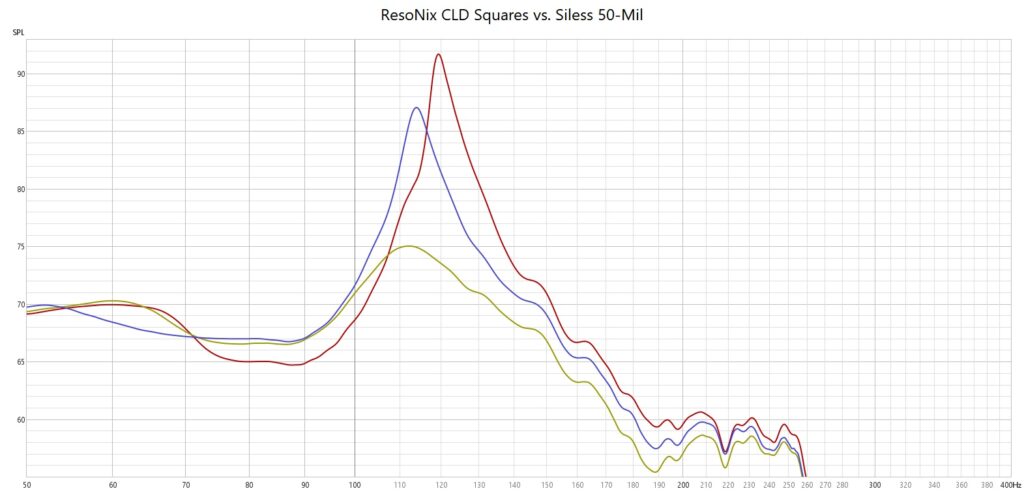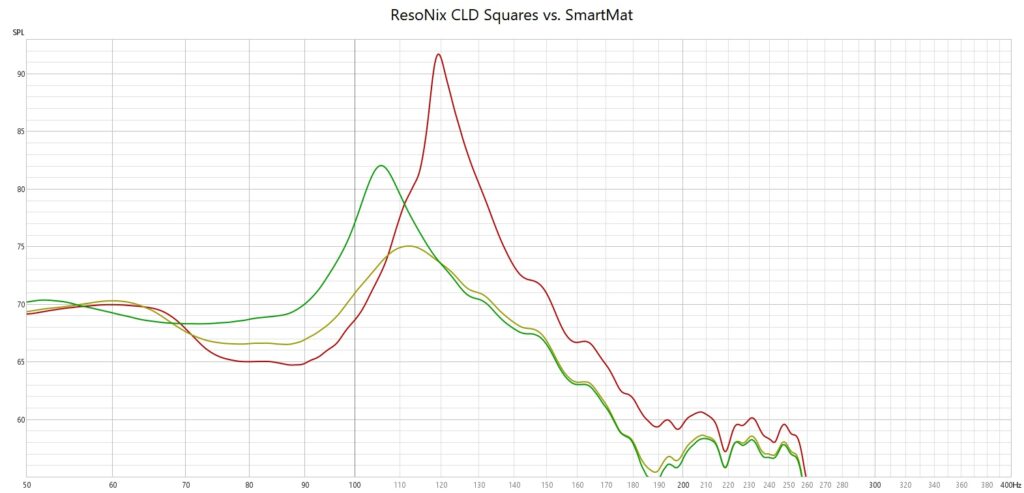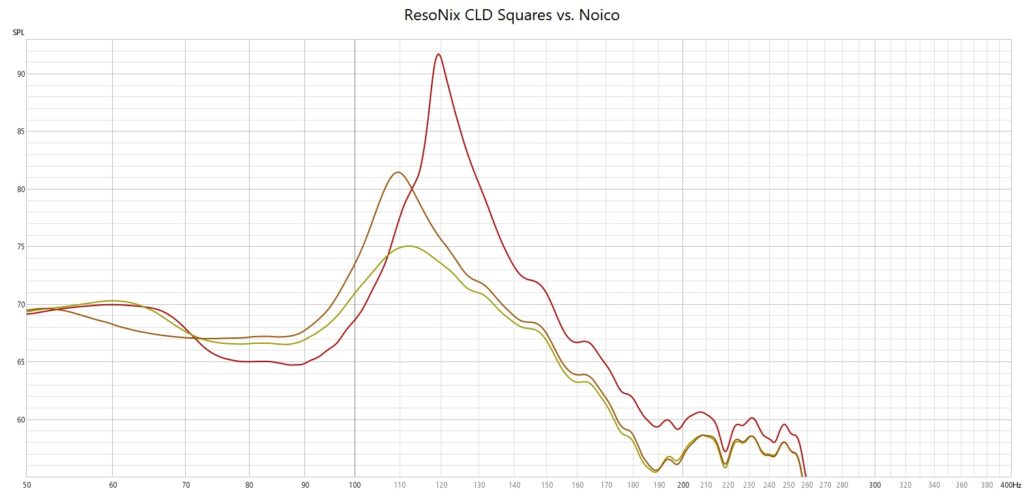Sound Deadening Material Independent Testing Data
People Lie, Numbers Dont.
Curious about who makes the best sound deadening material? Well, here is an extensive set of objective testing with the data completely broken-down to back and explain the results.
Change log: Updated February 17th, 2023
Topics - Click to Quick Jump
Introduction & General Overview
The testing and results below are all from an independent enthusiast, Chris Purdue, who is on his own journey to find out what the best products are in the sound deadening market. Chris is a high-end car audio enthusiast, just like a lot of you reading this page, and has been so for over a decade. He has years of experience, and has a vast understanding of audio and how it works.
This journey of his started years ago on the diymobileaudio.com forums and his previous testing can be found there. His ongoing testing and new data from utilizing his new testing equipment(video below) can be found on his Facebook group named “The Deadening” (link below).
The following data is all from this group – posted by Chris. If something about the article contradicts the data he has published for the world to use, please, let me know as it is nothing but a simple mistake. We are just here to try and help everyone interpret his data in a way that’s easy to digest.
Test Equipment Overview
So, before we dissect the data, we need to understand how these tests were done and what the data means. The first thing we need to go over is the test rig itself. The test rig is essentially two sealed enclosures with one shared wall separating them. The first enclosure is plain. Nothing about it is different from a standard sealed enclosure for a speaker. But the second enclosure has a removable metal panel that acts as the wall for the far end. Installed into the dividing wall is a speaker. The rear of the speaker fires into one enclosure. The front of the speaker fires into the second enclosure. A microphone placed just outside the metal panel measures acoustic data that the metal panel creates using the Room EQ Wizard measurement software. That information includes frequency response, impulse response, waterfall response, and more. This measurement is done before and after a Constrained Layer Damper is applied to the metal panel.
This gives us the before and after data and gives us an idea of how the CLD affects the panel. We can measure frequency response, as well as decay of the resonance. The two are typically correlated, but decay, while being more telling, is much harder to interpret into easy-to-understand numbers. So, for now, we are going to stick with frequency response. The frequency response will have a peak at the resonant frequency of said metal panel. In this case, that peak is around the 100hz area, which is also typical for a car door. We want to focus on how much reduction in amplitude this peak has to determine how effective the tested CLD is. The video below is of Chris explaining the test rig that he built and uses for testing as described above.
Best Car Sound Deadening Material Test Results
Car Sound Deadeners Independent Testing Data
- Resonance Reduction (dB)
- Sq Ft Equivalency Chart
- Price to Performance Equivalence
ResoNix Mega CLD
19 dB reduction
ResoNix
17 dB reduction
3M EDP1029
10.25 dB reduction
Amazon Basics
11.5 dB reduction
Soundskins Pro
9 dB reduction
Soundshield SSD 3-in-1
7 dB reduction
Boommat
8.25 dB reduction
Canopus
11 dB reduction
Dynamat Extreme
8 dB reduction
Harmony
13.75 dB reduction
Hushmat
10.25 dB reduction
Kilmat 80mil
7.25 dB reduction
Koxuyim
11 dB reduction
STP Aero
10.25 dB reduction
STP Gold
12.5 dB reduction
STP Silver
7.75 dB reduction
Sonic Barrier MX4
5.75 dB reduction
NVX CLD
11.5 dB reduction
Roadstage 3-in-1
8.5 dB reduction
Second Skin Damplifier Pro
11.5 dB reduction
Siless 80mil
8.25 dB reduction
Siless 50mil
4.75 dB reduction
Smartmat
9.75 dB reduction
Noico
9.5 dB reduction
Noico with Noico Roller
9.75 dB reduction
Noico with aggressive roller
7.5 dB reduction
The Measurements Of Sound Deadener Performance, & How To Interpret Them
Moving on to actually reading the results that are generated by Chris’s testing rig… The Decibel scale is measured logarithmic instead of linear. Every 3-decibel change, the energy is doubled or halved. If you have a speaker playing something at 85dB, twice the amount of energy is needed to hit 88dB. You will need twice the amount of power applied to the speaker or twice the number of speakers to achieve the 88dB. If you double the number of speakers and double the amount of power, that would be a 6dB addition. 50 decibels is NOT half as loud, or half the energy of 100 decibels. Pretty simple, right? Good. Let’s recap with bullet points real quick just in case.
- The decibel system is logarithmic, not linear.
- 3dB up is twice the energy. 3dB down is half the energy.
- 50dB is NOT half of 100dB. 25dB is not half of 50dB.
- 97dB is half the energy of 100dB. 103dB is 2x as much energy as 100dB.
- =10^(dB/10) is the formula for those who wish to know
ResoNix Mega CLD
.63 Sq Ft
ResoNix
1 Sq Ft
3M EDP1029
4.75 Sq Ft
Amazon Basics
3.75 Sq Ft
Soundskins Pro
6.5 Sq Ft
Soundshield SSD 3-in-1
10 Sq. Ft.
Boommat
7.75 Sq. Ft.
Canopus
4 Sq. Ft.
Dynamat Extreme
8 Sq. Ft.
Harmony
2.25 Sq. Ft.
Hushmat
4.75 Sq. Ft.
Kilmat 80mil
9.5 Sq. Ft.
Koxuyim
4 Sq. Ft.
STP Aero
4.75 Sq. Ft.
STP Gold
2.85 Sq. Ft.
STP Silver
8.5 Sq. Ft.
Sonic Barrier MX4
13.5 Sq. Ft.
NVX CLD
3.6 Sq. Ft.
Roadstage 3-in-1
7.1 Sq. Ft.
Second Skin Damplifier Pro
3.6 Sq. Ft.
Siless 80mil
7.5 Sq. Ft.
Siless 50mil
17 Sq. Ft.
Smartmat
5.5 Sq. Ft.
Noico
5.65 Sq. Ft.
Noico with Noico Roller
5.25 Sq. Ft.
Noico with aggressive roller
9 Sq. Ft.
Square Footage Required To Match 1 Sq.Ft of ResoNix CLD Squares
(Lower Is Better)
Calculated via the amount of dB reduction on the given test panel. +3dB = 2x … 10^(dB/10). Can be viewed as a reverse performance multiplier. Example: a rating of 5 would mean the product is 5x worse than a product with a rating of 1.
ResoNix Mega CLD
$7.40
ResoNix
$8.50
3M EDP1029
$42.85
Amazon Basics
$9.71
Soundskins Pro
$65.78
Soundshield SSD 3-in-1
$109.10
Boommat
$54.48
Canopus
$11.00
Dynamat Extreme
$41.76
Harmany
$11.57
Hushmat
$32.97
Kilmat 80mil
$16.91
Koxuyim
$9.32
STP Aero
$28.50
STP Gold
$11.76
STP Silver
$23.04
Sonic Barrier MX4
38.48
NVX CLD
$9.00
Roadstage 3-in-1
Price not available
Second Skin Damplifier Pro
$27.61
Siless 80mil
$13.95
Siless 50mil
$22.61
Smartmat
$10.62
Noico
$34.52
Noico with Noico Roller
$32.08
Noico with aggressive roller
$54.99
Rating Sound Deadener Performance
The rating system is simple. A CLD is supposed to do one thing and one thing only. Reduce resonance from a panel. So, while it’s the main focus, we will also be including a price-to-performance rating to give an idea of how products compare to what your dollar gets you. This price-to-performance rating is simple. The price per square foot of the product multiplied by its effectiveness in comparison to ResoNix.
Example: If ResoNix proves to be 2x better (3db difference) than another product, we take the price per square foot of the other product, and multiply it by 2. If this product costs $6.50 per square foot, and ResoNix costs $8.20 per square foot, we can now value the price to performance at $13 for this other product. While it may be cheaper, its not as good of an overall value as ResoNix.
Spoiler alert: ResoNix CLD Squares are currently the best independently tested product on the market. And frankly, it isn’t very close either. We expected this since our goal was to make the best performing product, hands down. Still, since it performed so well, we will use the ResoNix CLD Squares results as the reference.
Testing Our
Competitors
Everything You Need To Know About Automotive Sound Deadening & Sound Treatment Products.
Unfortunately, there is a lot of misinformation and marketing fluff out there when looking for
information on properly sound deadening your vehicle. I’m writing this to clear up any
misconceptions about installing any sound treatment to your car, as well as provide an easy-tofollow,
step-by-step guide that doesn’t misguide you for one reason or the other.
The Full Explanation Of Sound Deadener Performance - The Individual Measurements
Reference Measurements – No CLD Applied
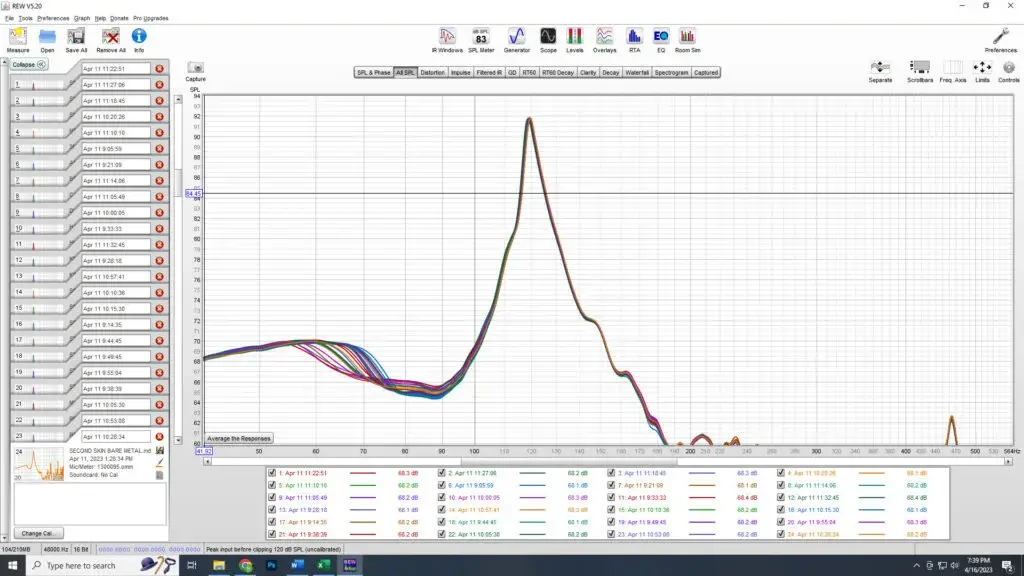
Each product received a “before” measurement with no product applied to act as a reference. The only variance that exists is well below our resonance frequency. This resonance frequency is visualized as a sharp peak, and is the area we will be paying attention to, which is from about 100Hz to 150Hz for this specific test panel. Since all of the “before” measurements are very similar, we will just be using one randomly picked before measurement to keep things relatively simple.
- CLD vs. Mega CLD Comparison
- vs. 3M EDP 1029
- vs. Amazon Basics
- vs. Boommat
- vs. Canopus
- vs. Soundshield 3-in-1
- vs. SoundSkins Pro
- vs. Dynamat Extreme
- vs. Harmany
- vs. Hushmat
- vs. Kilmat 80mil
- vs. Koxuyim
- vs. STP Aero
- vs. STP Gold
- vs. STP Silver
- vs. Sonic Barrier MX4
- vs. NVX CLD
- vs. Roadstage 3 - in 1
- vs. Second Skin
- vs. Siless 80mil
- vs. Siless 50mil
- vs. Smartmat
- vs. Noico

CLD
vs.

Mega CLD
Resonance Reduction
(25% Coverage of Panel)
17 dB
19dB
Price to Performance Equivalent*

CLD
$8.50
vs.

Mega CLD
$7.40
ResoNix CLD Squares Sound Deadener Performance
First up, and the product that will act as the reference for the rest of the comparisons, ResoNix CLD Squares. As you can see in the multiple before/after measurement, panel resonance has a 17dB reduction with the application of ResoNix CLD Squares. As mentioned earlier, this is going to be our reference. So from here on out, if another product has a 3db difference from ResoNix, ResoNix would be 2x as effective. If it had a 6db difference, it would be 4x as effective. If there is a 9db difference, that would be 8x as effective. 12db difference, 16x more effective, and so on. Remember, the db scale is logarithmic.
ResoNix CLD Test 1 Results.
ResoNix CLD Test 2 Results.
ResoNix Mega CLD Squares Sound Deadener Performance
Next up, ResoNix Mega CLD Squares. Our goal going into making this product was taking our original ResoNix CLD Squares and doing what we can within reason to make them even better, even though they were already the best on the market at the time.
This set of measurements was taken at a later date when Chris was doing another form of testing, so excuse the slightly different scaling.
ResoNix Mega CLD Test Results.
Above Graph Zoomed for Clarity.
As you can see in the multiple before/after measurement, panel resonance has a 19dB reduction with the application of ResoNix Mega CLD Squares. This 2db increase in resonance reduction puts the new ResoNix Mega CLD Squares as 1.6 times better than the original ResoNix CLD Squares. Coming in at $11.75 per square foot, this allows them to have an equal performance value of $7.40 vs the original ResoNix CLD Squares. Since this is the only product to have a better performance than the reference we are using for the data in this article (the original ResoNix CLD Squares), we had to take the inverse of the efficiency increase, which came out to 0.6299, and multiply that by its price, which gives us $7.40. Looks like our new ResoNix Mega CLD Squares is not only a better performer than our original ResoNix CLD Squares & the rest of the products, but also a better value than all of them as well.
ResoNix Mega CLD Squares Sound Deadener Performance vs Other Popular Brands
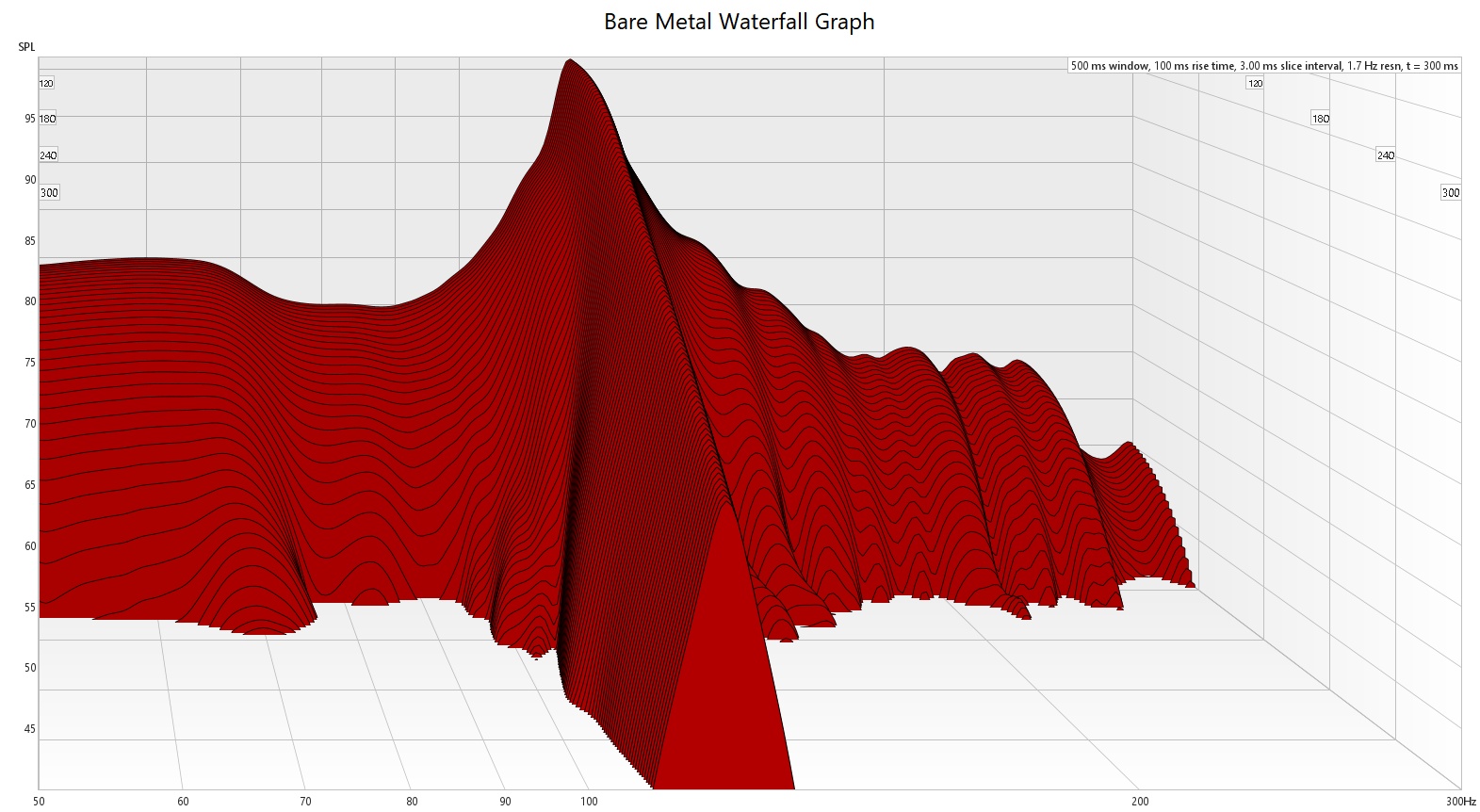
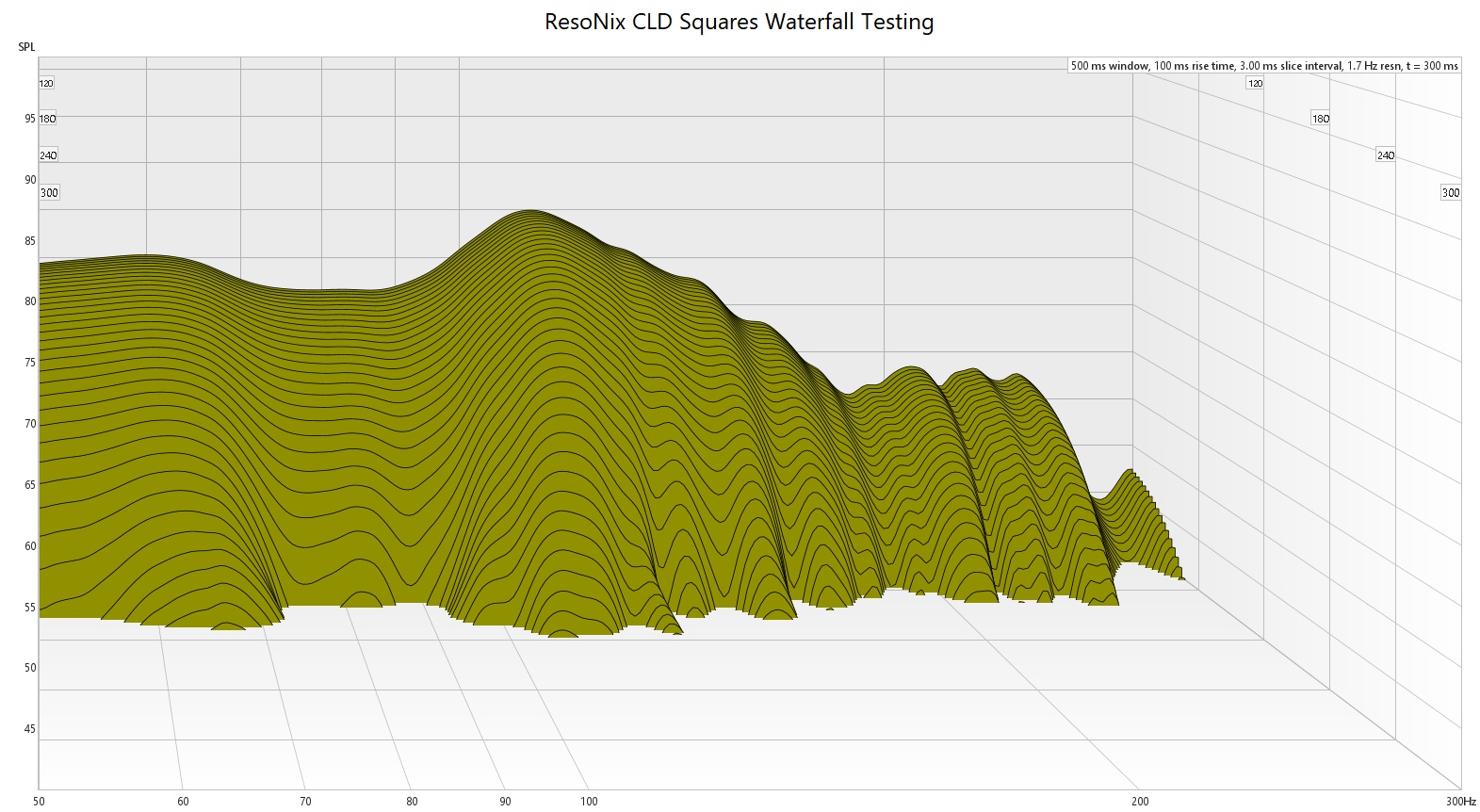
ResoNix CLD Squares vs. Bare Metal Waterfall Graph.

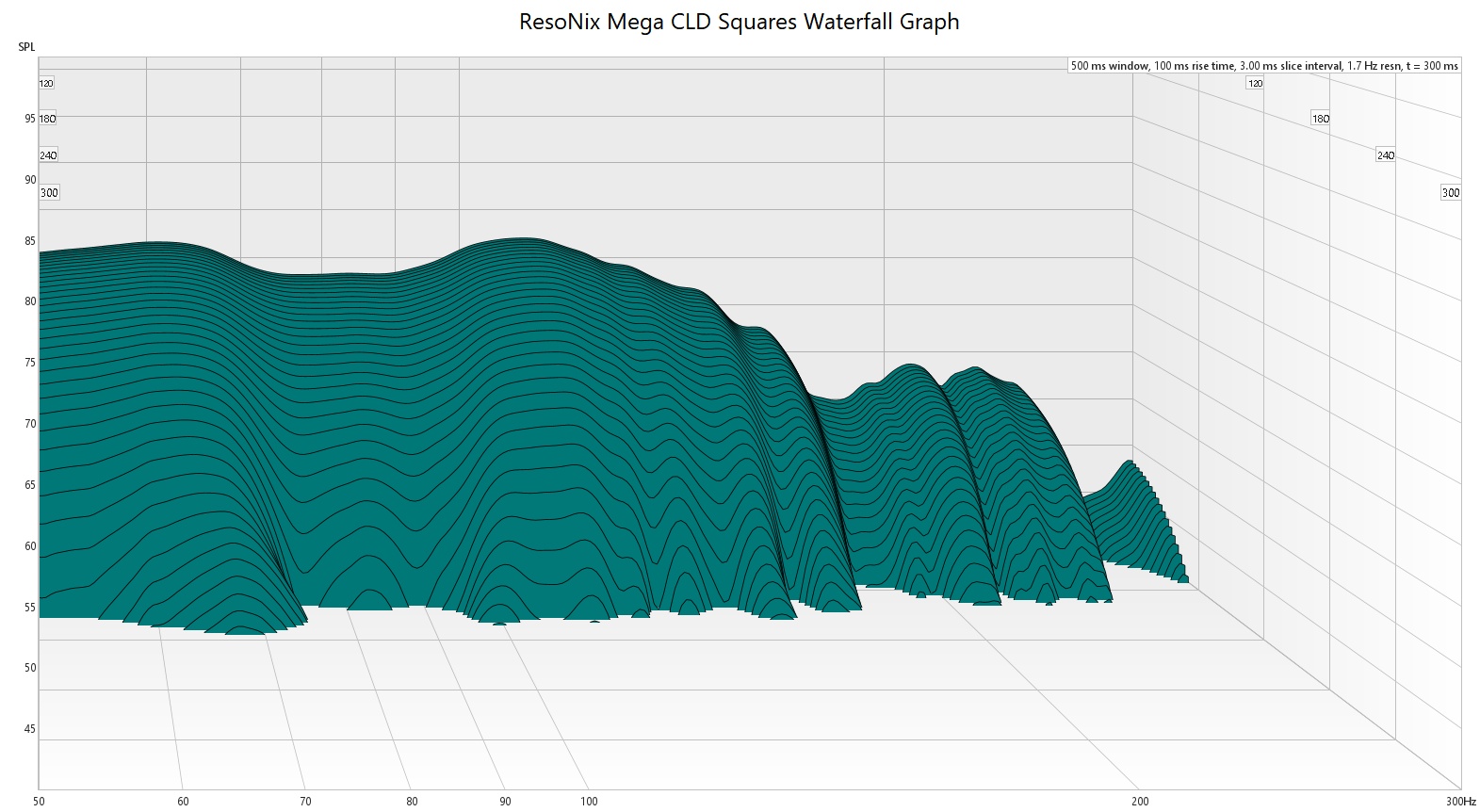
ResoNix Mega CLD Squares vs. Bare Metal Waterfall Graph.
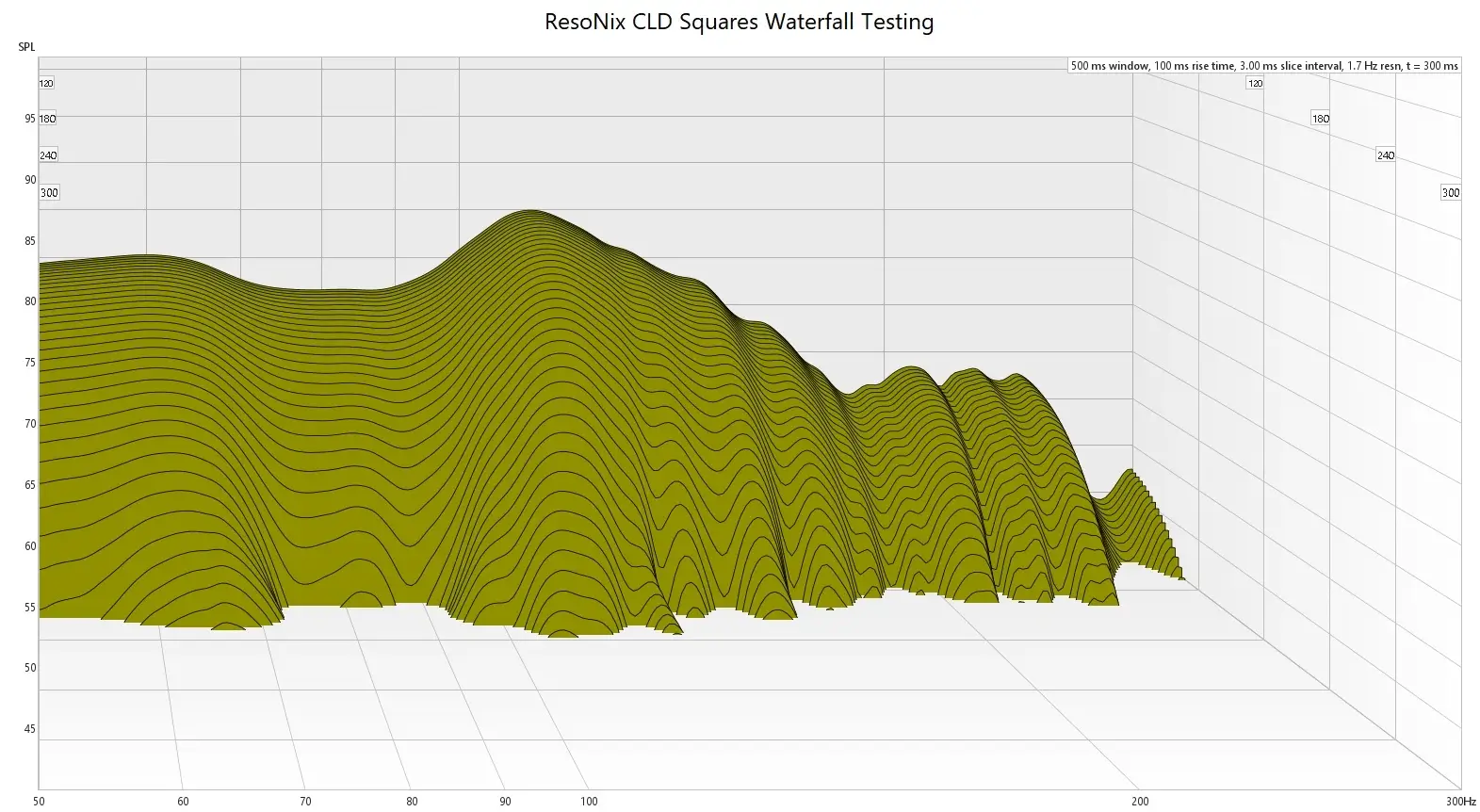

ResoNix Mega CLD Squares vs. Original ResoNix CLD Squares Waterfall Graph.

vs.
3M EDP1029
Resonance Reduction
(25% Coverage of Panel)
17 dB
10.25 dB
ResoNix CLD Squares are 4.75x more effective!
Price to Performance Equivalent*

$8.50
vs.
3M EDP1029
$42.85
3M EDM Sound Deadener Performance
Up next is 3M’s EDM. This is a new product that is different from traditional Butyl/Aluminum CLD’s. Its purpose is to be extremely light yet practical. The downside is, you pay a premium for the lightweight for average performance. We are leaving the ResoNix CLD measurement visible to use as a visual gauge, but remember, another product being visually halfway in between the “before” peak and the ResoNix measurement does not mean the other product is half as good. Remember, every 3db difference is 2x the energy. In the original testing, 3M measures at 96dB (we are rounding to the nearest half dB in favor of the product to make this easier) vs. the Before Measurement of 106.5dB. 10.5dB is the amount of resonance reduction we have. In the new round of testing, it reduced the peak by 10.25db, so pretty much the same result. 6.75db less than ResoNix, making ResoNix about 4.75x as effective per square foot.
We were able to find this product for as low as $9.02 per square foot. We can calculate that, in theory, you would need to spend $42.85 to get enough of the 3M product to achieve the same result as the $8.50, 1 Square foot of ResoNix CLD Squares. In the original testing, this is the worst value product in the entire test regarding resonance reduction. In the new testing that features more products, there are some that are grossly more overpriced.
ResoNix vs. 3M EDM Test 1 Results.
ResoNix vs. 3M EDM Test 2 Results.
3M EDM Sound Deadener Performance vs Other Popular Products
The 3M EDM Sound Deadener performs variably compared to other popular sound deadening products. It is significantly outperformed by ResoNix CLD Squares, which reduced resonance by 6.75db more, making ResoNix 4.75 times more effective. However, 3M EDM outperforms Dynamat Extreme, with a 2.25db greater reduction in resonance, making it 1.7 times better. It also shows better performance than Kilmat 80mil, achieving a 3db additional drop in resonance, resulting in 2 times better effectiveness. Additionally, 3M EDM is 1.35 times more effective than Soundskins, with an extra 1.25db reduction in resonance.
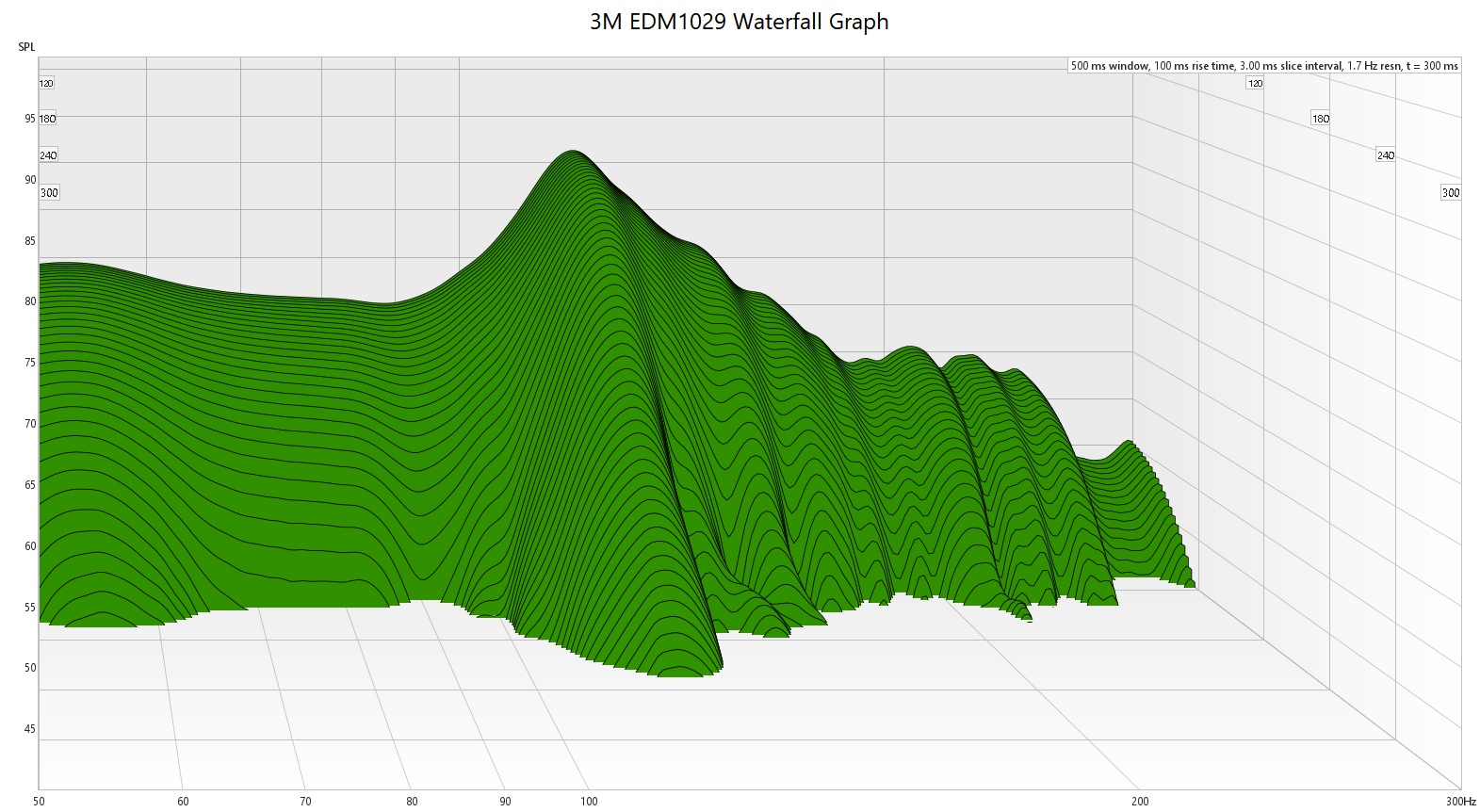
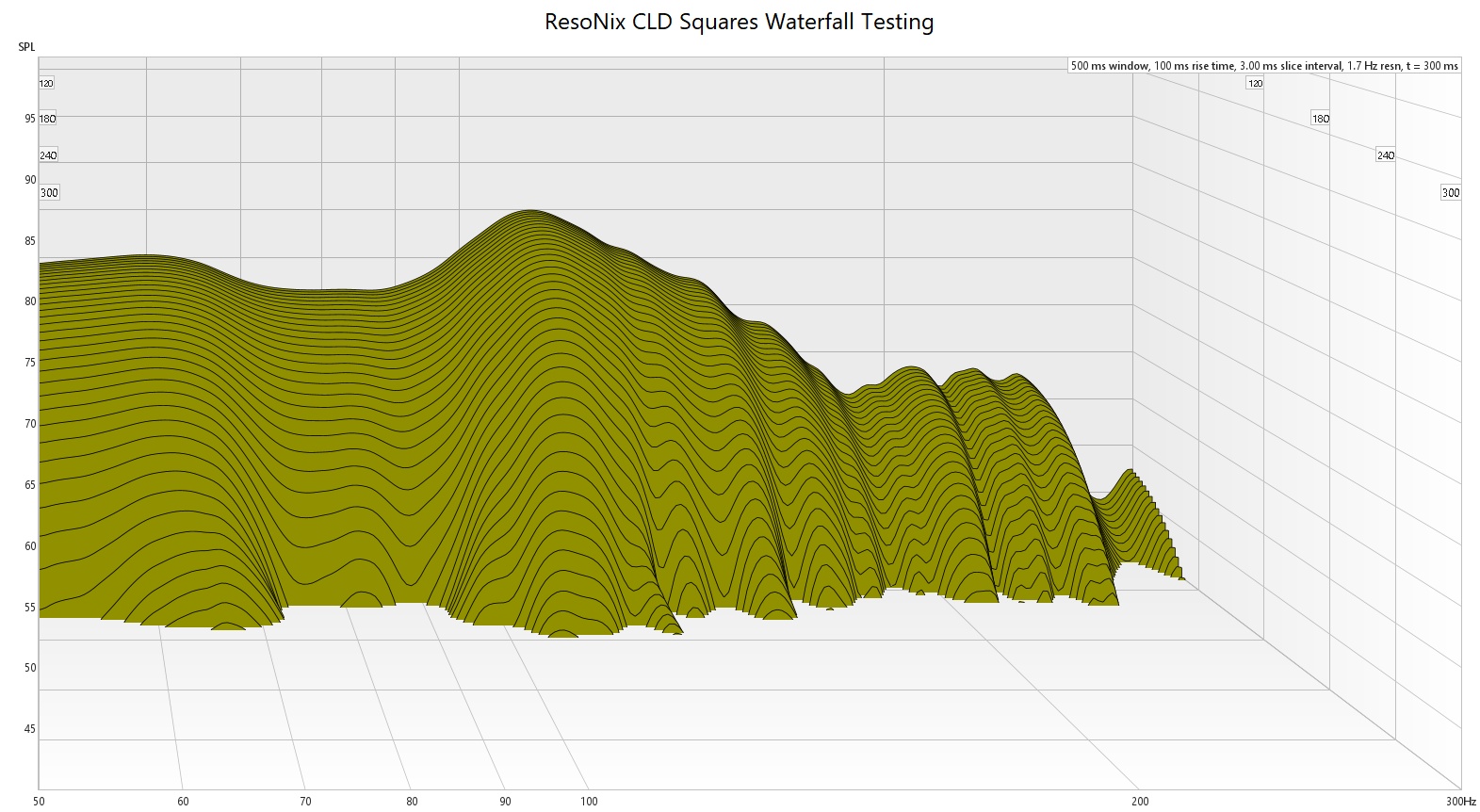
ResoNix vs. Soundskins Waterfall Graph.

vs.
Amazon Basics
Resonance Reduction
(25% Coverage of Panel)
17 dB
11.5 dB
Price to Performance Equivalent*

$8.50
vs.
Amazon Basics
$9.71
Amazon Basics Sound Deadener Performance
Next up, the king of consumerism.. Amazon Basics. A year or so ago as of writing this, Amazon decided to get their skin in the sound deadening game. Many are weary, as we know it is most likely that they didn’t have a smidge of care and just found the cheapest thing they can put their name on and distribute worldwide, as with all things they put under the Amazon Basics name. So let’s see what the data says.
ResoNix vs. Amazon Basics Test Results.
Turns out, its actually not half bad. There was one note that Chris mentioned in his testing, and it was that the adhesive on the Amazon Basics sound deadener was very easy to remove, which may be a negative thing for longevity, but it’s hard to say. So, resonance reduction comes in at 11.5db, which puts it in the middle of the pack, better than most. In relation to ResoNix CLD Squares 17db reduction, ResoNix comes in at 3.75x better than Amazon Basics sound deadener, and puts Amazon Basics CLD at a price to performance ratio of $9.71 vs ResoNix $8.50. Close, but no cigar. I am eager to see how it does in Chris’s heat testing.
Amazon Basics Sound Deadener Performance vs Other Popular Brands
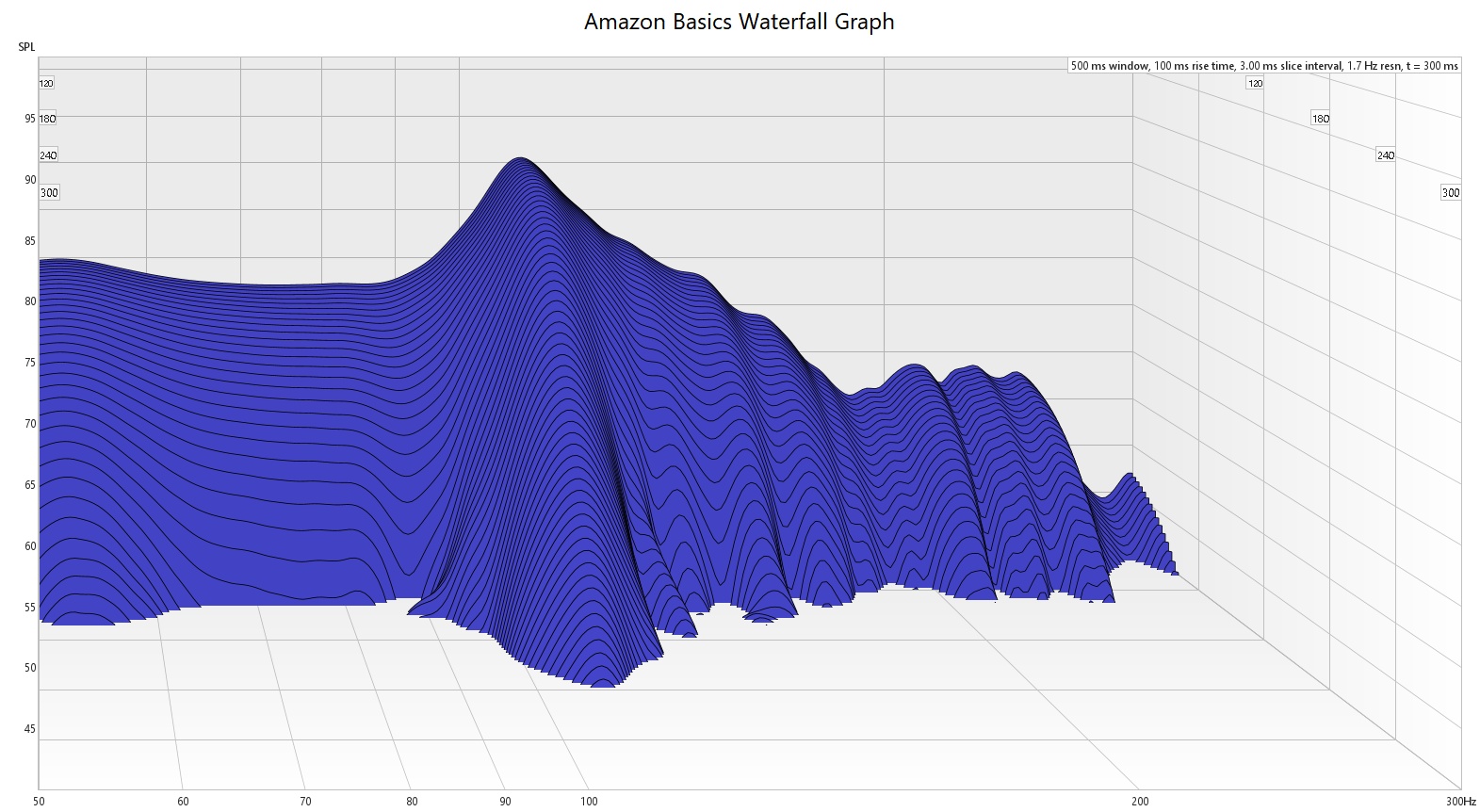

ResoNix vs. Soundskins Waterfall Graph.

vs.
Boommat
Resonance Reduction
(25% Coverage of Panel)
17 dB
8.25 dB
Price to Performance Equivalent*

$8.50
vs.
Boommat
$54.48
Boommat Sound Deadener Performance
Next up is Boommat. Honestly, I’m not really sure what to say about them as I havent paid much attention to them at all and have never seen their products in person. So, lets dive into the test results.
For resonance reduction, Boommat reduced the resonance peak of the test panel by 8.25db, so this is a pretty low performer. ResoNix being at 17db resonance reduction puts it as 7.75x better than Boommat. This gives Boommat, which comes in at $7.03 per square foot, a price to performance ratio of $54.48. So not only is it a low performer, it is also a poor value.
ResoNix vs. Boommat Test Results.
Boommat Sound Deadener Performance vs Other Popular Brands
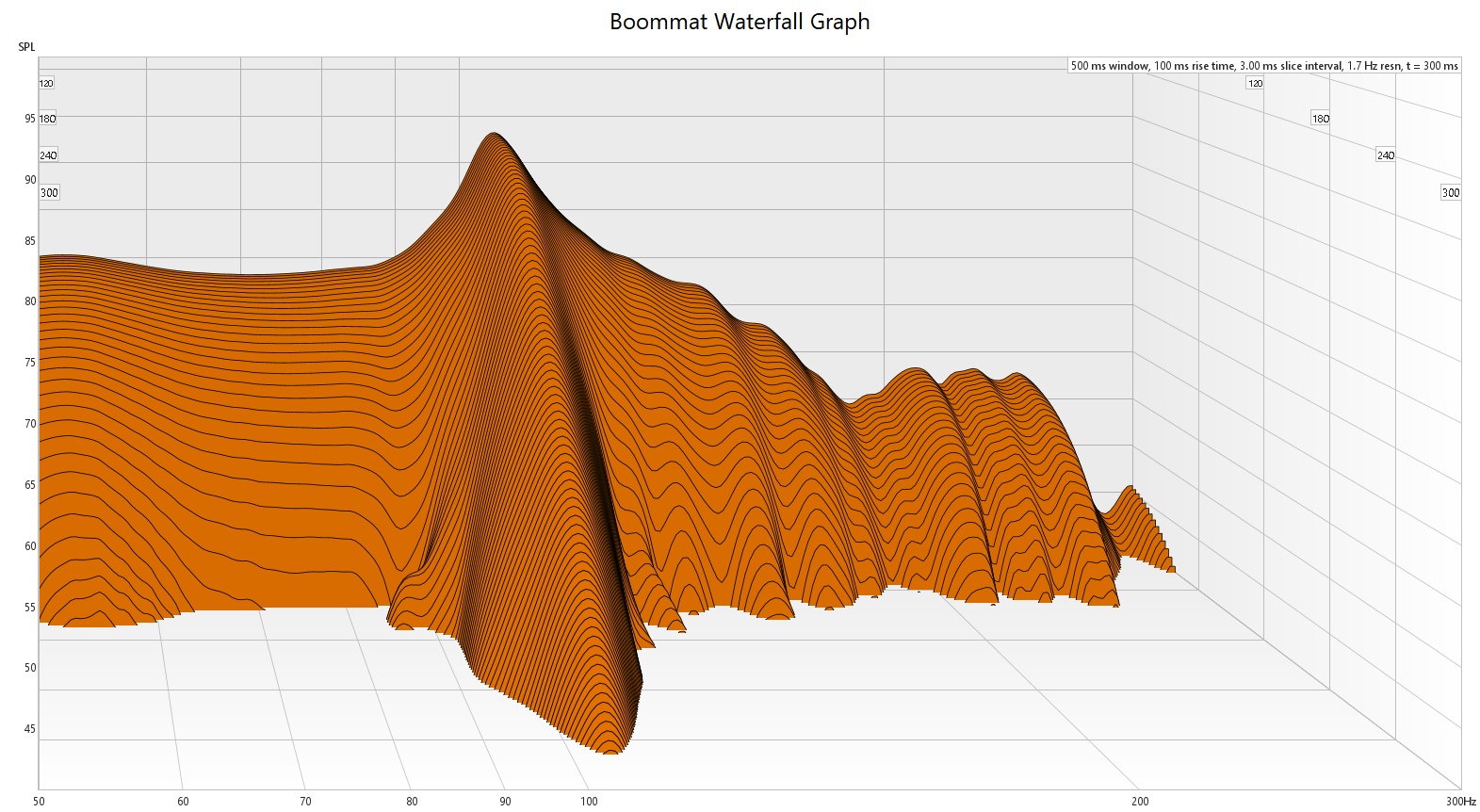

ResoNix vs. Boommat Waterfall Graph.

vs.
Canopus
Resonance Reduction
(25% Coverage of Panel)
17 dB
11 dB
Price to Performance Equivalent*

$8.50
vs.
Amazon Basics
$11.00
Canopus Sound Deadener Performance
ResoNix vs. Canopus Test Results.
Canopus Sound Deadener Performance vs. Other Popular Brands
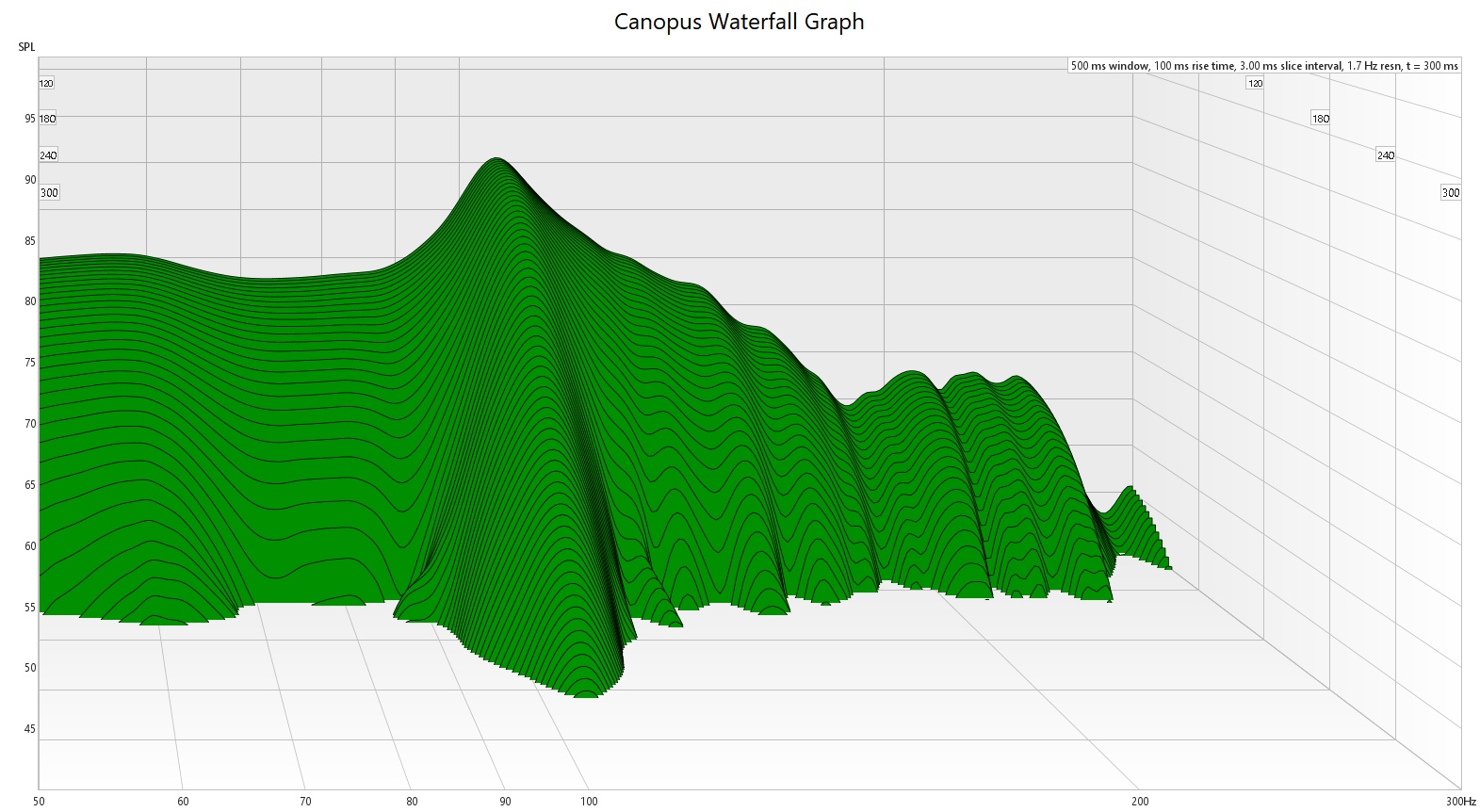

ResoNix vs. Canopus Waterfall Graph.

vs.
Soundshield SSD 3-in-1
Resonance Reduction
(25% Coverage of Panel)
17 dB
7 dB
ResoNix CLD Squares are 10x more effective!
Price to Performance Equivalent*

$8.50
vs.
Soundshield SSD 3-in-1
$109.10
SoundShield Sound Deadener Performance
ResoNix vs. SoundShield Results.
SoundShield Sound Deadener Performance vs Other Popular Brands
SoundShield 3-in-1 sound deadener shows carrying effectiveness when compared to other popular brands. It is significantly less effective than ResoNix CLD Squares, which reduced the test panels’s resonance by 10db more, making ResoNix 10 times more effective. Against Dynamat Extreme, sSoundShield is slightly less effective, with Dynamat reducing resonance by an additional 1db, resulting in Dynamat being 1.25 times better. In comparison with Soundskins, a similar product with a shared business history, SoundShield is outperformed as Soundskins reduced the test panels resonance by 2db more, making it 1.6 times more effective. I’m sure we can all guess why a business using the same original manufacturer of both would opt for a lower performing product, but that’s probably pretty easy to guess and for you to decide.
Spoiler Alert: Price to performance wise, SoundShield comes in as the worst of any product tested so far by a long shot. Considering it is $10.91 per square foot, and ResoNix is 10x as effective, it can be calculated to have a price to performance of $109 to ResoNix $8.50. Yikes. Considering the resonance control performance, history of melting from the manufacturer, and price to performance ratio… I have no words.
Soundskins Sound Deadener Performance
Another “3-in-1” product from “that” manufacturer and is another popular option among car audio shops. Due to the history of SoundSkins/Soundshield in the US, I always suspected they were identical products. While I don’t expect much from the aforementioned manufacturer or the brands that order from them, they can still request different thicknesses in butyl, aluminum, and foam, which can change performance. It’s hard to say because these companies don’t even seem to care enough to put thickness specs in their literature. Let’s see if my suspicions were correct.
Turns out, I was wrong. It looks like SoundSkins is a slightly better performer than SoundShield. There is most likely a difference in butyl thickness. This may also explain why there are more reports of SoundSkins melting than there are of SoundShield (less butyl, the less of a chance it has to run/drip).
Update: It turns out Soundskins changed manufacturers as of recent, which can explain the step up in performance from SoundShield, and similar performance to Roadstage Audio.
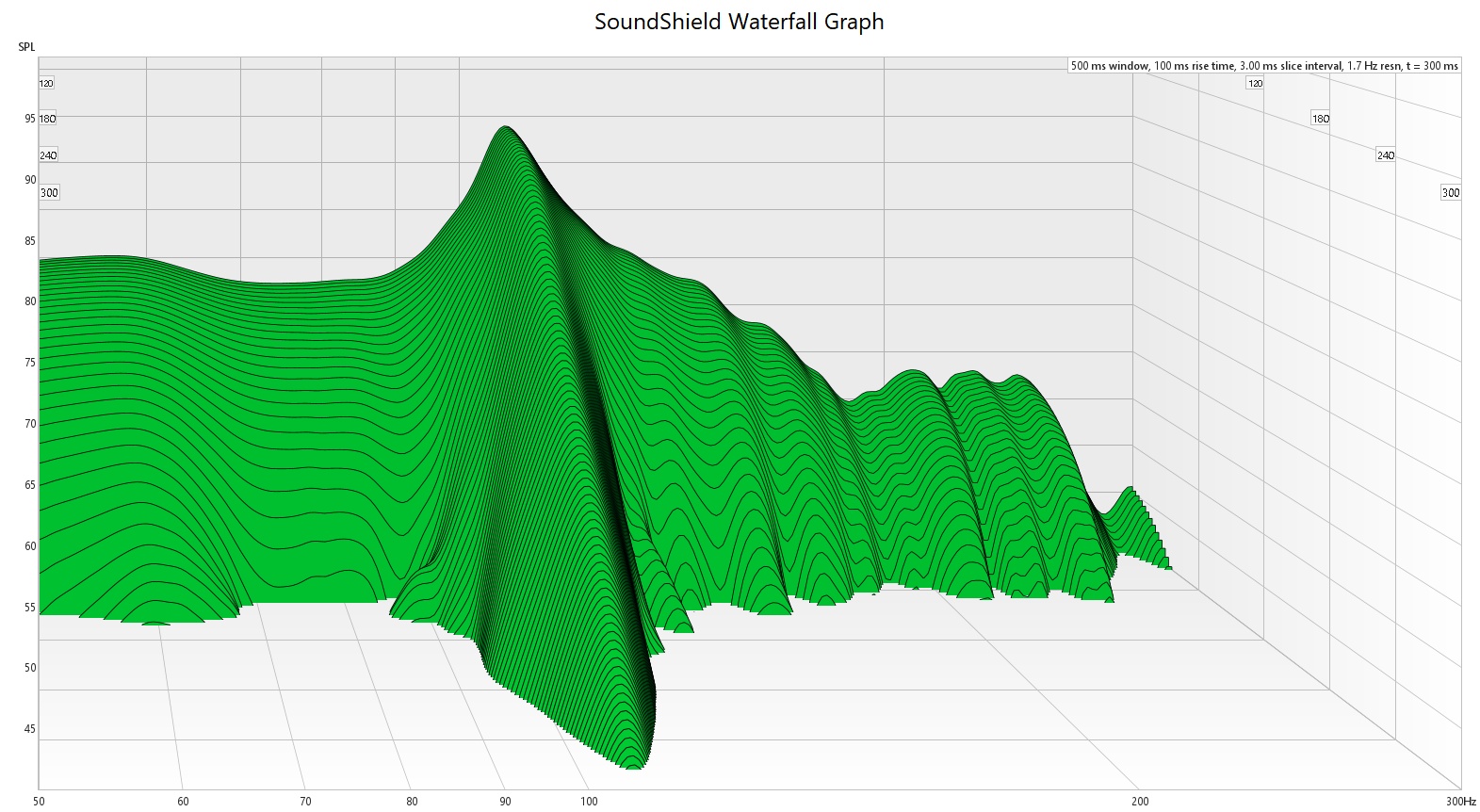

ResoNix vs. SoundShield Waterfall Graph.

vs.
SoundSkins Pro
Resonance Reduction
(25% Coverage of Panel)
17 dB
9 dB
Price to Performance Equivalent*

$8.50
vs.
SoundSkins Pro
$65.78
Soundskins Sound Deadener Performance
Another “3-in-1” product from “that” manufacturer and is another popular option among car audio shops. Due to the history of SoundSkins/Soundshield in the US, I always suspected they were identical products. While I don’t expect much from the aforementioned manufacturer or the brands that order from them, they can still request different thicknesses in butyl, aluminum, and foam, which can change performance. It’s hard to say because these companies don’t even seem to care enough to put thickness specs in their literature. Let’s see if my suspicions were correct.
ResoNix vs. Soundskins Results.
Soundskins Sound Deadener Testing Results
SoundShield Sound Deadener Performance vs Other Popular Brands
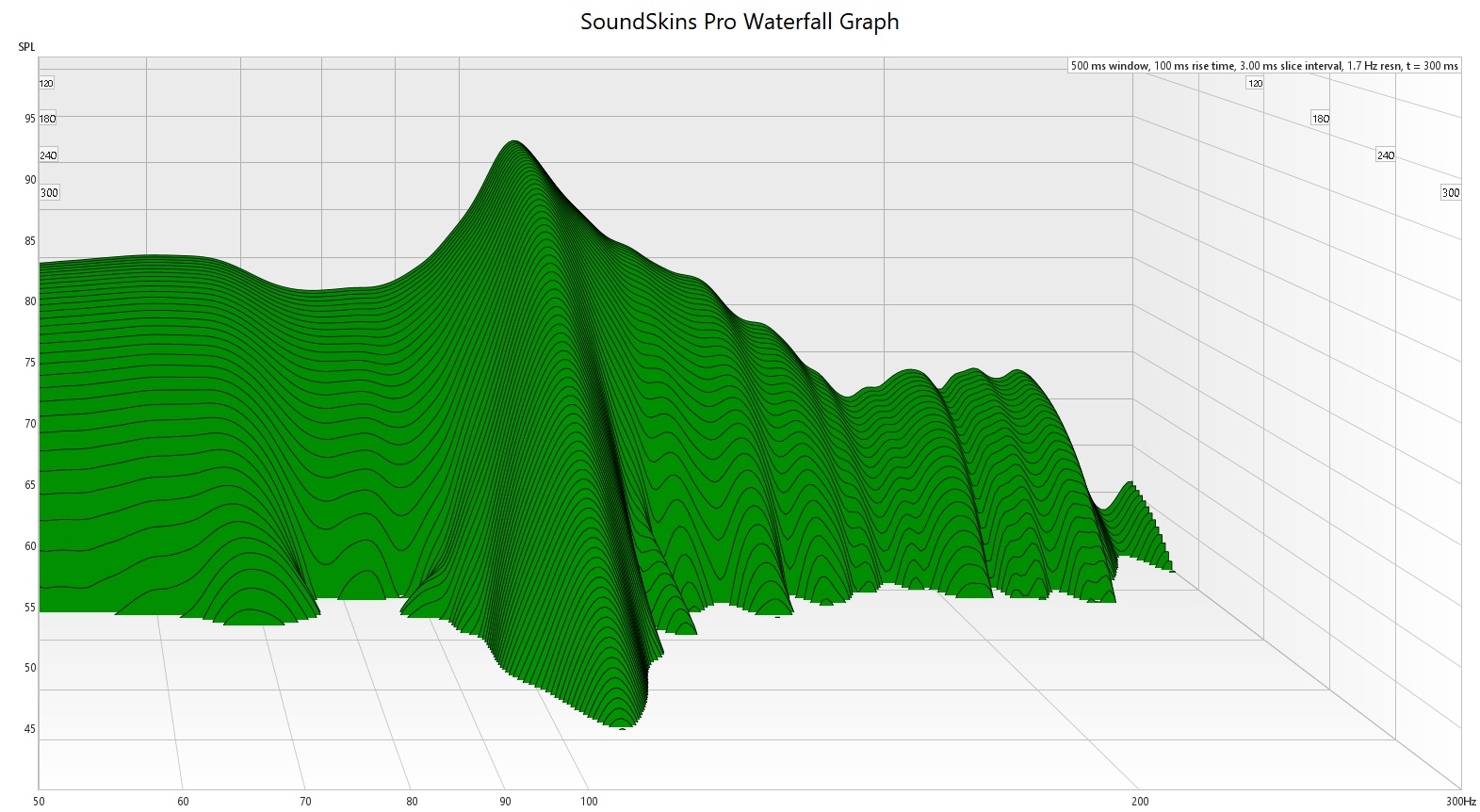

ResoNix vs. Soundskins Waterfall Graph.

vs.
Dynamat Extreme
Resonance Reduction
(25% Coverage of Panel)
17 dB
8 dB
Price to Performance Equivalent*

$8.50
vs.
Dynamat Extreme
$41.76
Dynamat Extreme Sound Deadener Performance
Next up is the Kleenex of sound deadener, Dynamat Extreme. This is the most popular product for aftermarket automotive use worldwide, and they have been around for decades. Looking at the measurements from the original test, Dynamat Extreme drops the peak in the resonant frequency from 106.5dB to 98.5dB. An 8dB reduction in the resonance of the test panel. In the new test, it also drops it exactly 9db. ResoNix being at a 17dB reduction in the test panel, is 8x as effective as Dynamat Extreme per given amount (9dB more equates to 8x the amount of energy). So, for every square foot of ResoNix CLD Squares, you would need 8 square feet of Dynamat Extreme to, in theory, yield the same result.
ResoNix vs. Dynamat Test 1 Results.
At the time of writing this, we were able to find Dynamat Extreme online for as low a $5.22 per square foot. This generates a price-to-performance of $41.76 vs. ResoNix $8.50. In theory, to get the same end result as ResoNix, you would be paying 5x the overall price and doing 8x the work overall. In reality, it wouldnt be possible to match the performance of ResoNix CLD Squares with Dynamat Extreme since the performance ceiling is so much lower on Dynamat Extreme, unless doing very minimal coverage with ResoNix. This is not a good value.
ResoNix vs. Dynamat Test 2 Results.
Dynamat Extreme Sound Deadener Performance vs Other Popular Brands
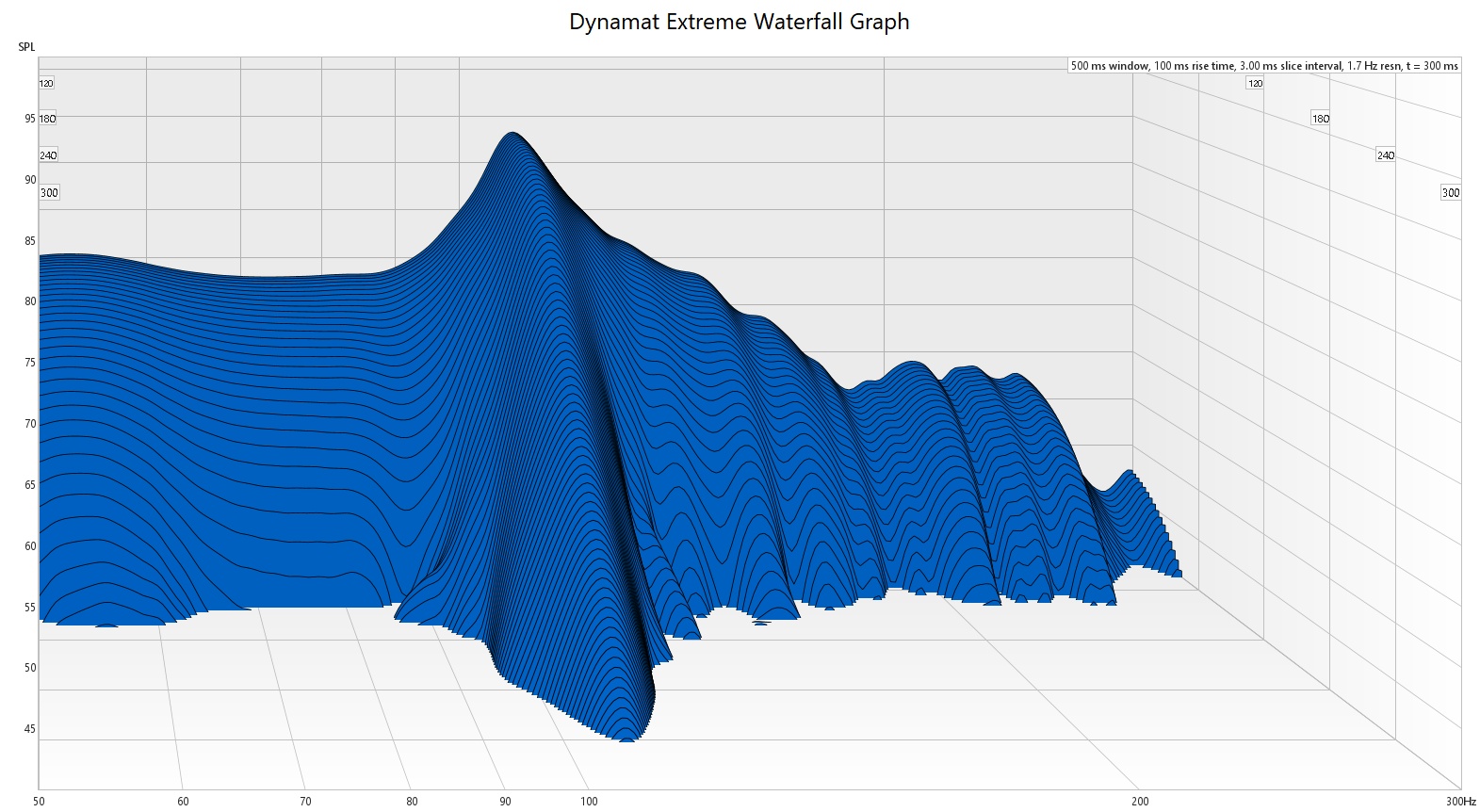

ResoNix vs. Dynamat Waterfall Graph.

vs.
Harmany
Resonance Reduction
(25% Coverage of Panel)
17 dB
13.75 dB
Price to Performance Equivalent*

$8.50
vs.
Harmany
$11.57
Harmany Sound Deadener Performance
ResoNix vs. Harmany Test Results.
Also like Knu Konceptz, while having very poor resistance to heat and melting, it has good resonance control. It is actually the second place product when it comes to resonance control. It reduced the resonance peak of the test panel by 13.75db, which puts ResoNix CLD Squares as 2.25x better in resonance control performance. Coming in at $5.14 per square foot, it puts its price to performance ratio at $11.57 vs ResoNix CLD Squares $8.50. It is one of the better values of the bunch when it comes to resonance control, but like Knu Konceptz, I am very skeptical for how it will hold up in an automotive environment. Once again, I cannot wait to see Chris’s results from heat testing.
Harmany Sound Deadener Performance vs Other Popular Brands
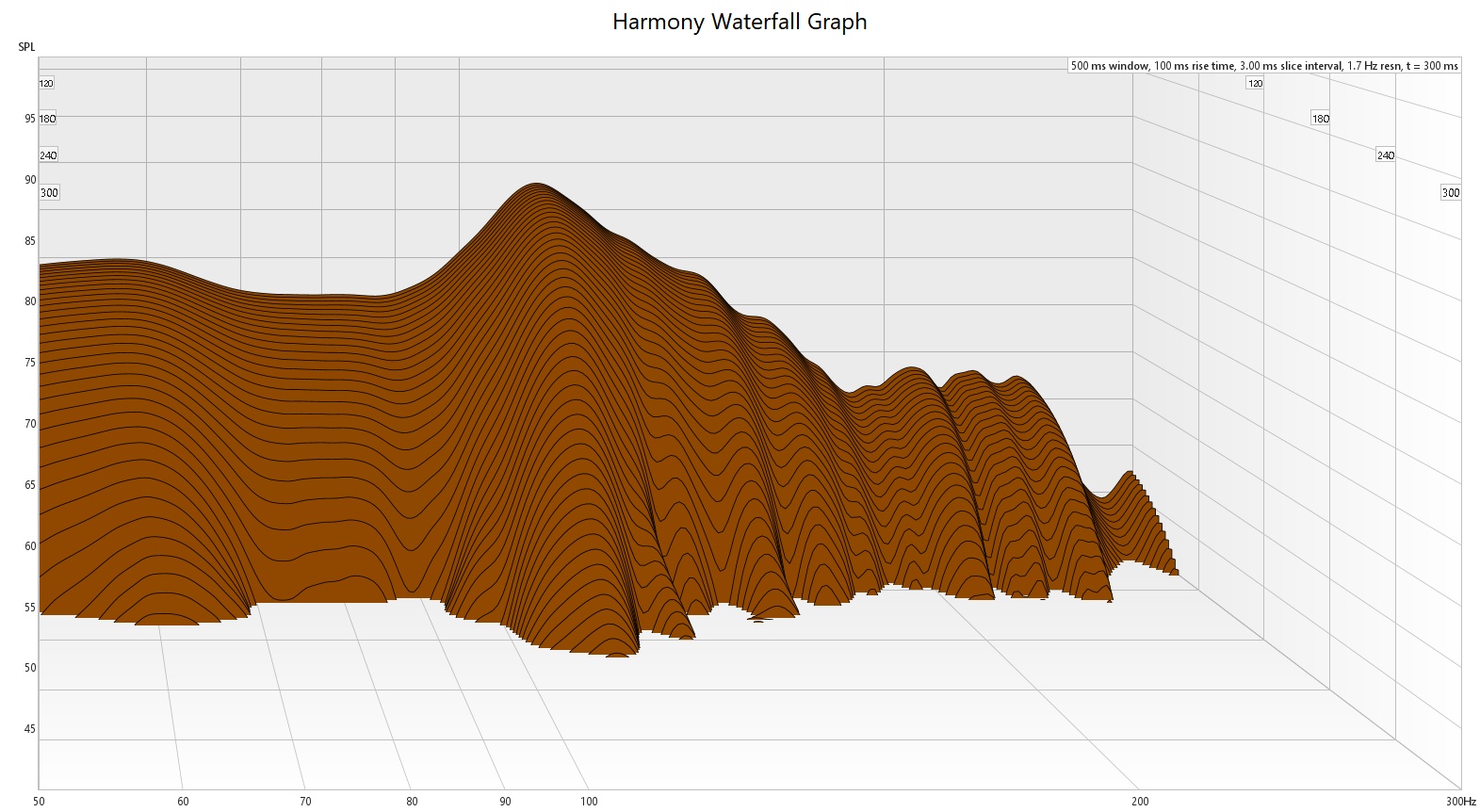

ResoNix vs. Harmany Waterfall Graph.

vs.
Hushmat
Resonance Reduction
(25% Coverage of Panel)
17 dB
10.25 dB
Price to Performance Equivalent*

$8.50
vs.
Hushmat
$32.97
Hushmat Sound Deadener Performance
ResoNix vs. Hushmat Test Results.
Hushmat Sound Deadener Performance vs Other Popular Brands
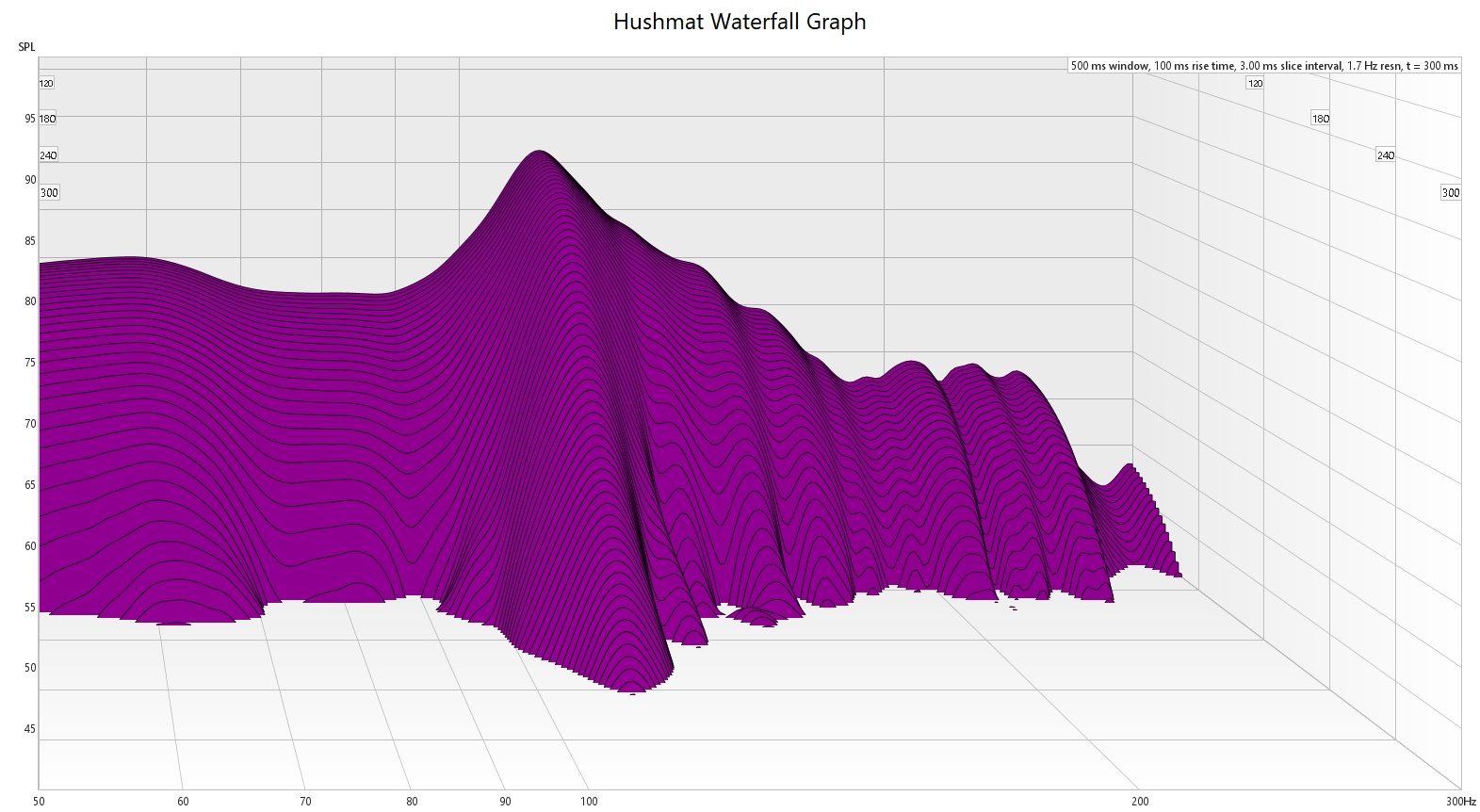

ResoNix vs. Hushmat Waterfall Graph.

vs.
Kilmat 80mil
Resonance Reduction
(25% Coverage of Panel)
17 dB
7.25 dB
Price to Performance Equivalent*

$8.50
vs.
Kilmat 80mil
$16.91
Kilmat 80mil Sound Deadener Performance
ResoNix vs. Kilmat 80mil Test 1 Results.
Second Round Of Kilmat 80mil Sound Deadener Testing
In the NEW round of testing, the performance of Kilmat dropped slightly, and this time had a resonance peak reduction of only 7.25db. Based on my experience with these products, I would think its safe to say that this performance decrease can be from two different things.
The manufacture either skimping on the quality of the product in more recent batches, or the butyl quality been very poor and degrading very quickly.
ResoNix vs. Kilmat 80mil Test 2 Results.
Now comparing to ResoNix CLD Squares. Since this is a 9.75db difference, it can be calculated that ResoNix is 9.5x as effective per given amount vs. Kilmat 80mil. Kilmat 80mil comes out to $1.78 per square foot, so doing the calculation, we get a price to performance value of $16.91 to, in theory, achieve the same result as a single square foot of ResoNix CLD. 9.5x as much would need to be applied in order to match the performance of ResoNix CLD Squares. More work to apply, more cost overall to achieve a given amount of performance. This, while seemingly low cost, is not a good value. Remember, subjective reviews on the internet are typically not a great source of accurate information. People lie, numbers don’t.
Kilmat 80mil Sound Deadener Performance vs Other Popular Brands
Kilmat 80mil Sound Deadener has varied effectiveness compared to other popular sound deadeners. It is significantly less effective than ResoNix CLD Squares, which achieved a 9.75db higher reduction in resonance, making ResoNix 9.5 times more effective. Against Dynamat Extreme, Kilmat 80mil performs almost equally, with both showing nearly identical effects in resonance reduction. However, Kilmat 80mil is slightly outperformed by Soundskins, which reduced resonance by an additional 1.25db, making Soundskins 1.35 times more effective than Kilmat 80mil.
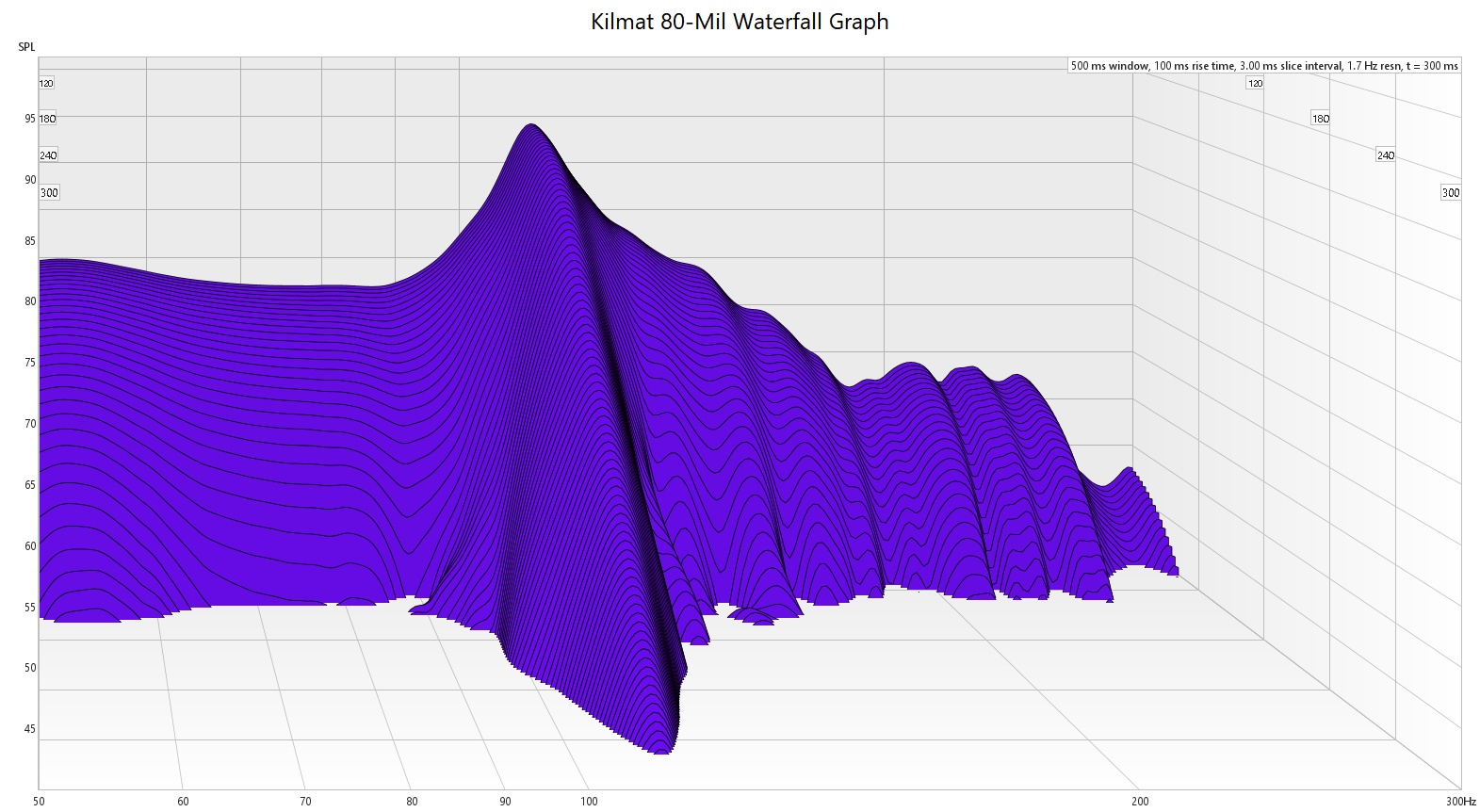

ResoNix vs. Kilmat 80mil Waterfall Graph.

vs.
Koxuyim
Resonance Reduction
(25% Coverage of Panel)
17 dB
11 dB
Price to Performance Equivalent*

$8.50
vs.
Koxuyim
$9.32
Koxuyim Sound Deadener Performance
Another product coming from Asia that I haven’t personally heard of, so let’s dive into the data. Koxuyim reduced the test panels resonance peak by 11db, which is about average, but puts ResoNix CLD Squares as 4x better.
Koxuyim comes in at $2.33 per square foot, which gives it a price to performance ratio of $9.32 vs ResoNix $8.50. Another close contender for value, but once again we have no idea how well it holds up to heat and will have to wait until Chris heat tests it.
ResoNix vs. Koxuyim Test Results.
Koxuyim Sound Deadener Performance vs Other Popular Brands
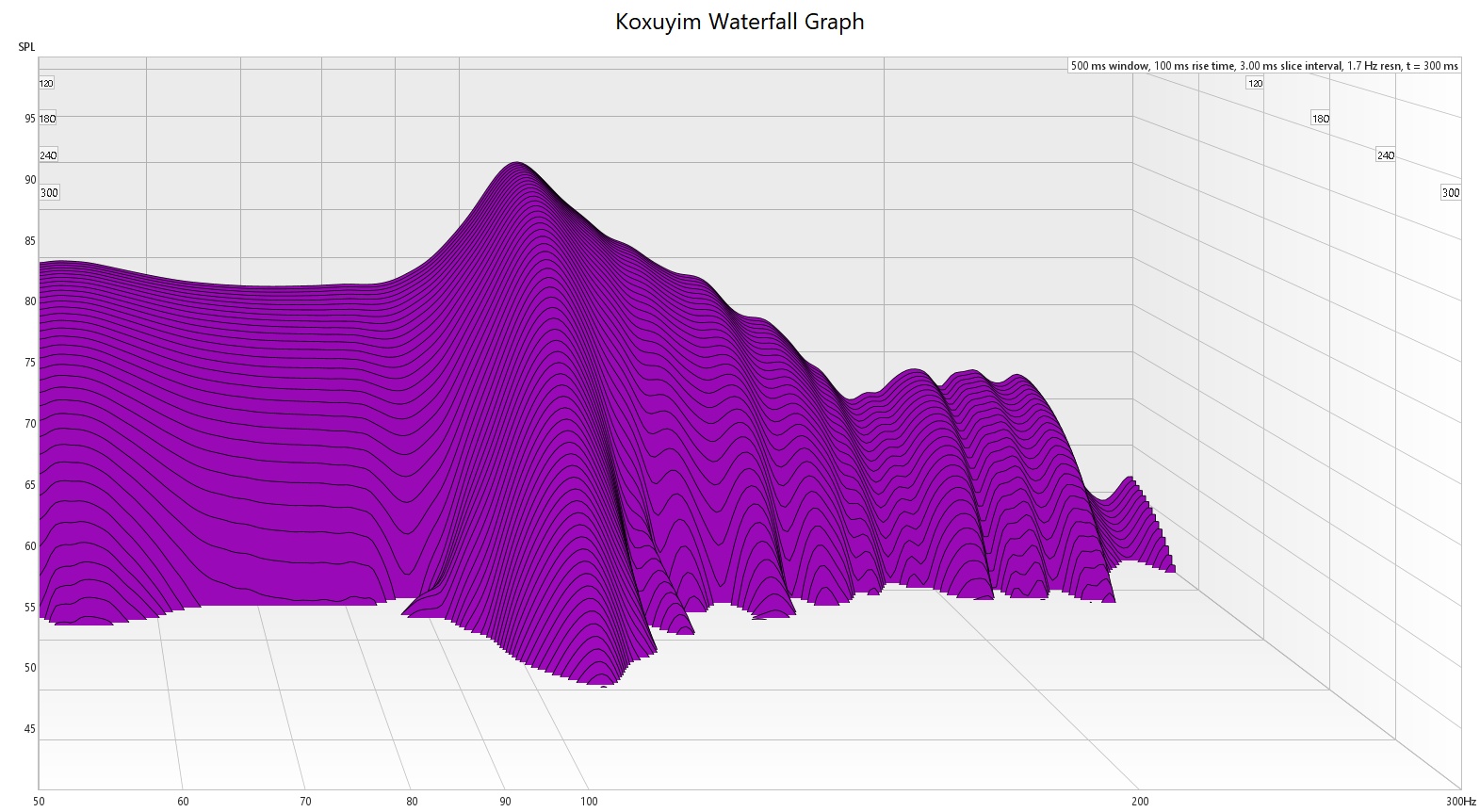

ResoNix vs. Harmany Waterfall Graph.

vs.
STP Aero
Resonance Reduction
(25% Coverage of Panel)
17 dB
10.25 dB
Price to Performance Equivalent*

$8.50
vs.
STP Aero
$28.50
STP Aero Sound Deadener Performance
STP Aero Sound Deadener Performance vs Other Popular Brands
STP Aero sound deadener goes a bit backwards in performance and is less effective than its STP Gold counterpart.
ResoNix vs. STP Aero Test Results.
It is also outperformed by ResoNix CLD Squares, with ResoNix reducing resonance by an additional 6.75db, making it 4.75 times more effective than STP Aero. However, STP Aero exceeds the performance of Dynamat Extreme, reducing resonance by 2.25db more, which makes it 1.7 times better. Compared to Soundskins, STP Aero is also more effective, with a 1.25db greater reduction in resonance, making it 1.35 times better. When pitted against Kilmat 80mil, STP Aero shows superior performance, reducing resonance by 3db more, making it 2 times more effective.
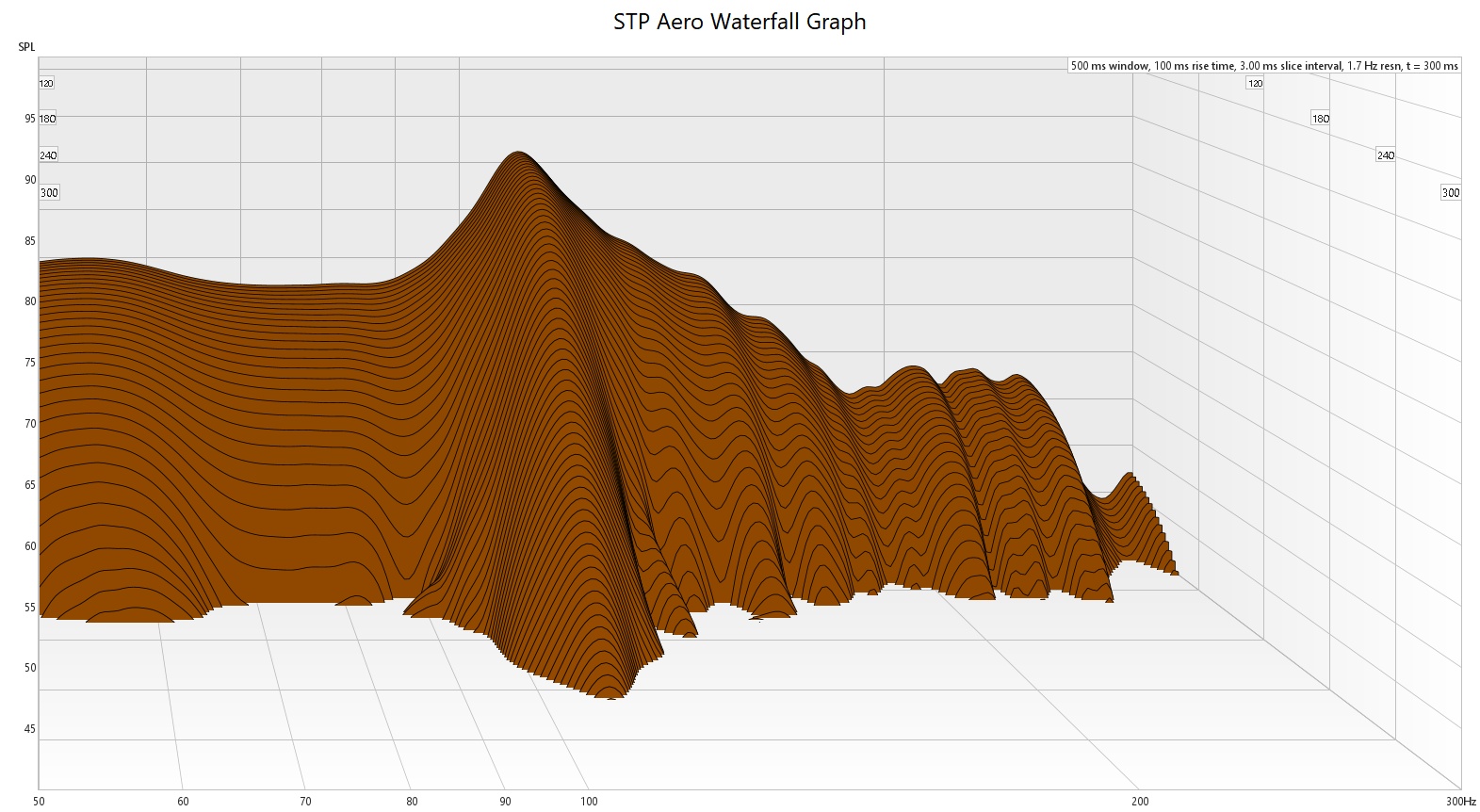

ResoNix vs. STP Aero Waterfall Graph.

vs.
STP Gold
Resonance Reduction
(25% Coverage of Panel)
17 dB
12.5 dB
Price to Performance Equivalent*

$8.50
vs.
STP Gold
$11.76
STP Gold Sound Deadener Performance
STP Gold is the same product, just a thicker version, of STP Silver. STP Gold reduced the test panel resonance by 12.5db, making ResoNix CLD Squares 2.85x more effective. STP Gold had a price of $4.13 per square foot, which gives it a price to performance of $11.76 vs ResoNix CLD Squares $8.50. Considering it is the same butyl formula as STP Silver and my experiences with that, I would not recommend it unless you live in a colder climate (I am in New York and still had issues).
STP Gold Sound Deadener Performance vs Other Popular Brands
STP Gold sound deadener performs a bit better than the STP Silver, but still varies between other popular brands.
ResoNix vs. STP Gold Test Results.
STP Gold Sound Deadener Performance vs Other Popular Brands
ResoNix CLD Squares, however, outperforms it by reducing resonance by an additional 4.5db, making ResoNix 2.8 times more effective. In contrast, STP Gold excels against Dynamat Extreme, outperforming it by 4.5db and thus being 2.8 times better. When compared to Soundskins, STP Gold is more effective, reducing resonance by 3.5db more, making it 2.25 times better. Against Kilmat 80mil, STP Gold shows even more superiority, achieving a 5.25db greater reduction in resonance, which makes it 3.4 times more effective.
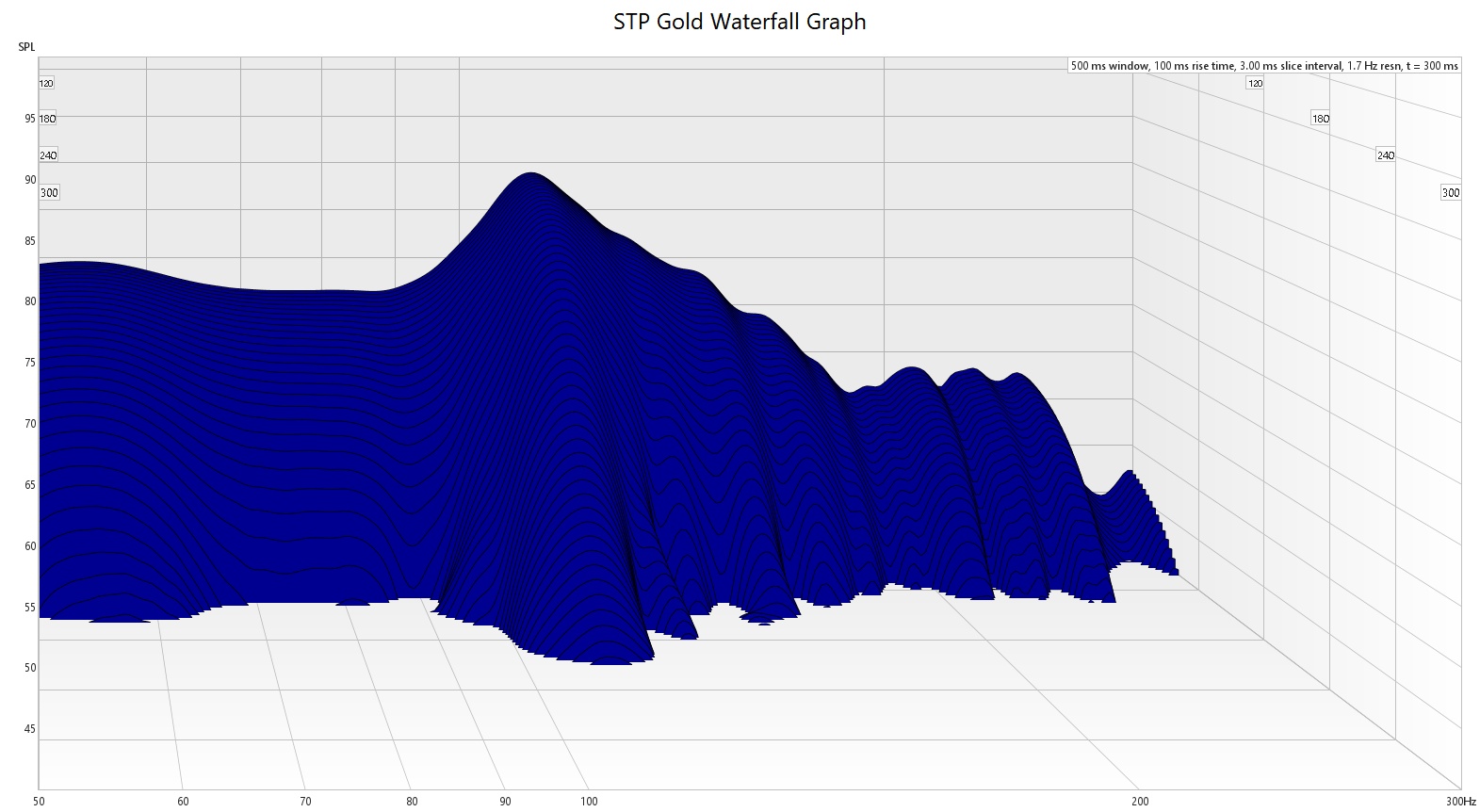

ResoNix vs. STP Gold Waterfall Graph.

vs.
STP Silver
Resonance Reduction
(25% Coverage of Panel)
17 dB
7.75 dB
ResoNix CLD Squares are 8.5x more effective!
Price to Performance Equivalent*

$8.50
vs.
STP Silver
$23.03
STP Silver Sound Deadener Performance
STP, short for Standartplast, is a Russian manufacturer that is the company that seems to make many of the other Amazon-sold products that are popular, such as Noico, Kilmat, etc. Since the start of the Ukranian war, STP products are no longer imported into the US, but we figured the data can be useful. I also have a lot of experience using this product since a shop I worked for years ago used it, and I always had a hunch that STP silver was the very same product as Kilmat or Noico, especially considering Standartplast makes both. Let’s see what the data says. According to Chris’s testing, STP Silver reduced the test panel resonance peak by 7.75db, close enough to Kilmat to say that they are probably the same product. With a reduction of 7.75db, it puts ResoNix as 8.5x better. According to the price sheet, it came in at $2.71 per square foot, which gives it a price to performance of $23.04 compared to ResoNix CLD Squares $8.50. Another thing to note, considering I have a lot of experience with this product from years of installing it while working at another shop, it does not hold up well to heat over time.
It tuned into a vaseline-like consistency after a couple years of being in my doors.
ResoNix vs. STP Silver Test Results.
STP Silver Sound Deadener Performance vs Other Popular Brands
STP Silver sound deadener has varying results when compared to other popular sound deadening products. It is significantly outperformed by ResoNix CLD Squares, with ResoNix reducing resonance by an additional 9.25db, making it 8.5 times more effective. However, STP Silver is slightly less effective than Dynamat Extreme, with Dynamat reducing resonance by only 0.25db more, which makes Dynamat 1.05 times better in performance. Compared to Soundskins, STP Silver is also less effective, with Soundskins reducing resonance by 1.25db more, making it 1.35 times better. When pitted against Kilmat 80mil, STP Silver performs slightly better, reducing resonance by an additional 0.5db, making it 1.12 times more effective.
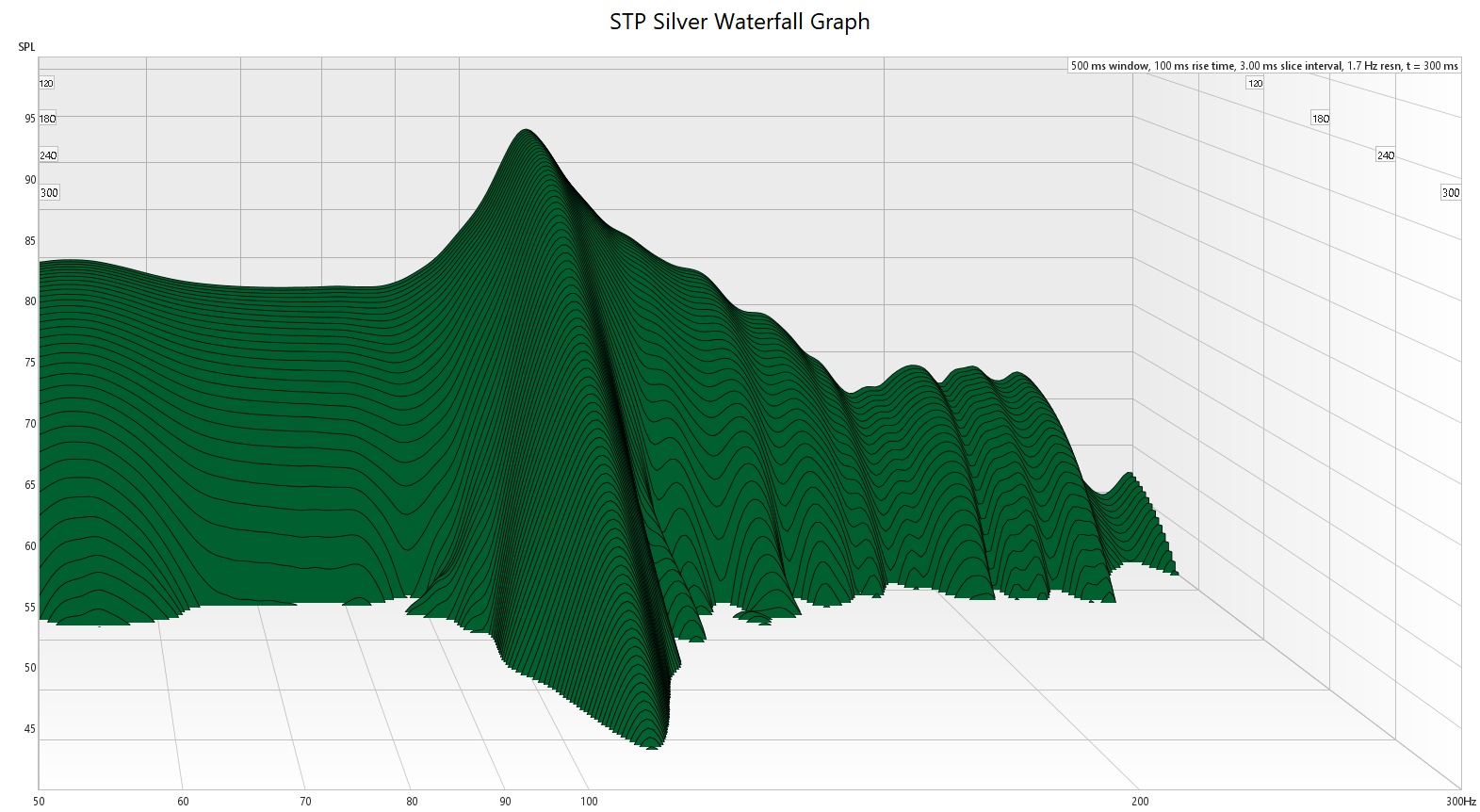

ResoNix vs. STP Silver Waterfall Graph.

vs.
Sonic Barrier MX4
Resonance Reduction
(25% Coverage of Panel)
17 dB
5.75 dB
Price to Performance Equivalent*

$8.50
vs.
Sonic Barrier MX4
$38.48
Sonic Barrier Sound Deadener Performance
ResoNix vs. Sonic Barrier Test 1 Results.
Sonic Barrier Sound Deadener Updated Testing
With the old testing, considering ResoNix had a 17dB reduction, we can calculate that ResoNix is exactly 10x as effective per given area covered than Sonic Barrier MX-4.
ResoNix vs. Sonic Barrier Test 2 Results.
We were able to find Sonic Barrier MX-4 for $2.85 per square foot. The price to performance value comes out to $28.50 vs. ResoNix at $8.50 per square foot. While the initial cost is attractive, this is not a good value.
Sonic Barrier Sound Deadener Performance vs Other Popular Brands
Note For Buyers & Users Of Sonic Barrier, and other "3-in-1" Sound Deadening Products
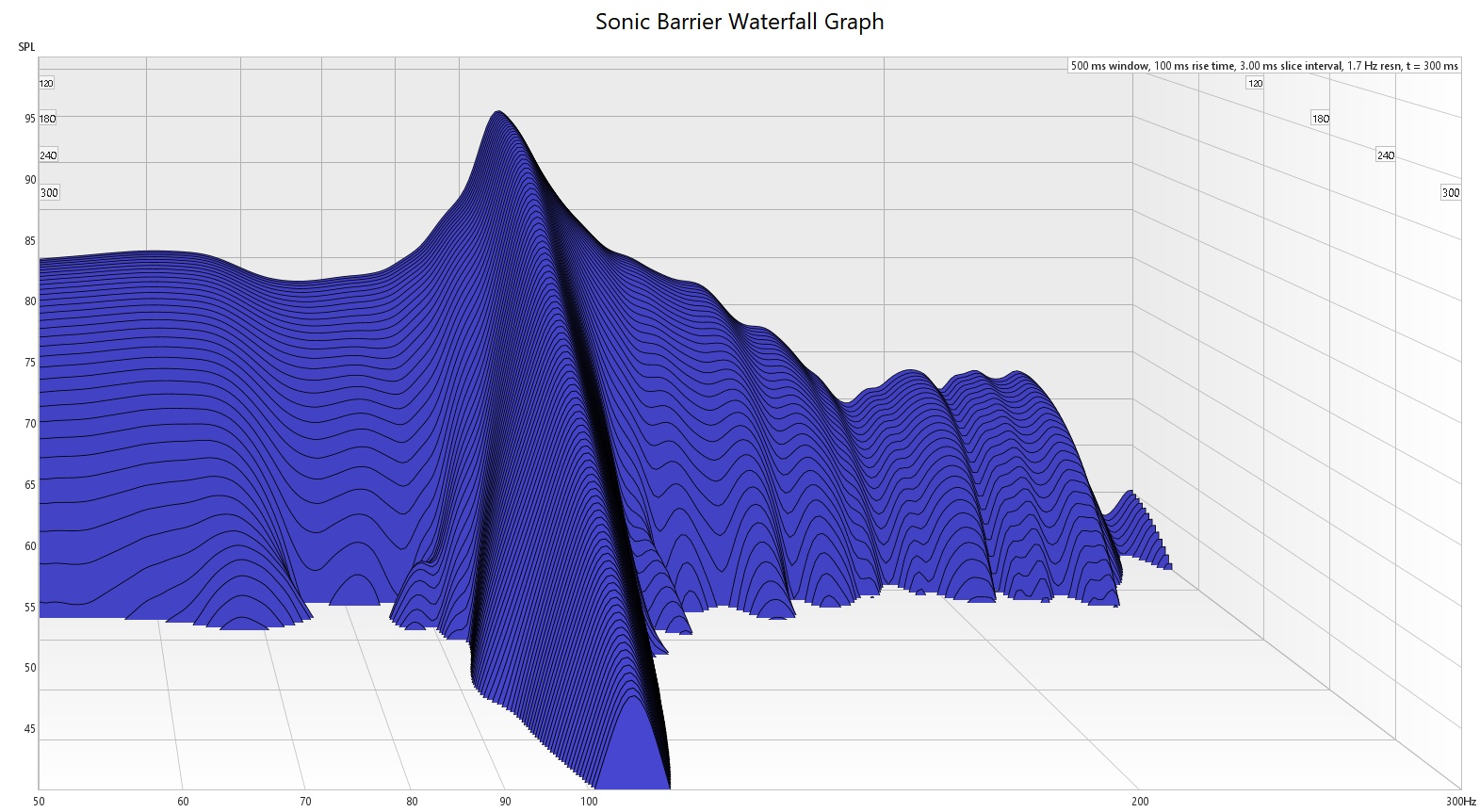

ResoNix vs. STP Aero Waterfall Graph.

vs.
NVX CLD
Resonance Reduction
(25% Coverage of Panel)
17 dB
11.5 dB
Price to Performance Equivalent*

$8.50
vs.
NVX CLD
$9.00
NVX Sound Deadener Performance
Next up is NVX 90mil. In both the original and more recent testing, it reduced the resonance peak by 11.5db. Not bad. Let’s see how it compares in value to ResoNix CLD Squares. We were able to find NVX 90mil for as low as $2.50 per square foot when buying a bulk pack. Remember, ResoNix reduces the test panel’s resonance by 17db. NVX 90mil reduced the panel’s resonance by 11.5db. Based on this, we can calculate that ResoNix is 3.6x as effective as NVX. This means you would need to, in theory, apply 3.6x as much NVX 90mil to the test panel to get the same reduction as a given piece of ResoNix CLD Squares.
Taking that 3.6x multiplier to their $2.50 per square foot price, we can calculate its price to performance would be $9, vs. ResoNix $8.50. We finally have something close, but when using this product, you would then have to go through the additional work of applying 3.6x as much product vs. ResoNix CLD Squares to get the same performance. Close, but no cigar.
ResoNix vs. NVX Test 1 Results.
ResoNix vs. NVX Test 2 Results.
NVX Sound Deadener vs Other Popular Brands
NVX Sound Deadener performs variably compared to other popular sound deadening products. It is less effective than ResoNix CLD Squares, which reduced resonance by 5.5db more (3.6 times better). However, NVX outperforms Dynamat Extreme by reducing resonance 3.5db more, making it 2.25 times better, although Dynamat Extreme has superior heat resistance. NVX is also more effective than Kilmat 80mil, offering a 4.25db additional reduction in resonance (2.7 times better). When compared to Soundskins 3-in-1, NVX performs 1.8 times better by reducing resonance by an extra 2.5db.
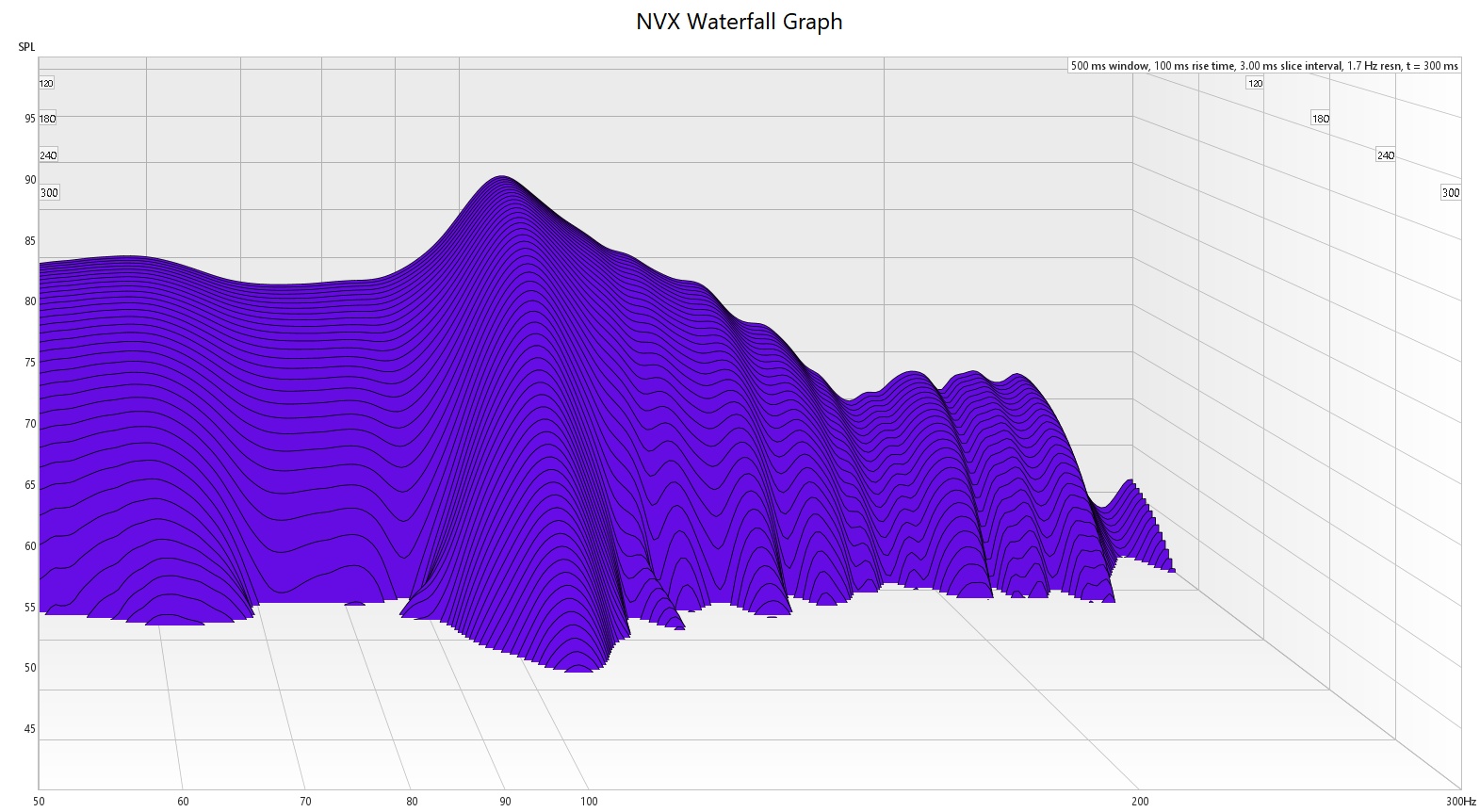

ResoNix vs. NVX CLD Waterfall Graph.

vs.
Roadstage 3-in-1
Resonance Reduction
(25% Coverage of Panel)
17 dB
8.5 dB
Price to Performance Equivalent*

$8.50
vs.
Roadstage 3-in-1
Price not available
Roadstage Audio Sound Deadener Performance
Next, we have Roadstage Audio, which is a “3-in-1” product. Butyl, foil, and foam all in one package. Lets see how effective it is at reducing panel resonance. As you can see on the graphs, Roadstage reduced the resonance peak by 8.5db in the original and more recent testing. ResoNix 17dB reduction allows us to calculate that ResoNix is 7.1x as effective per given amount compared to Roadstage Audio. I cannot find a website for Roadstage, let alone pricing, so we have no way to calculate the price to performance ratio. That said, I have a hard time believing that it’s cheap enough (especially considering it’s a 3-in-1 product) to be anywhere in the ballpark of the value of ResoNix CLD Squares.
ResoNix vs. Roadstage Audio Test 1 Results.
ResoNix vs. Roadstage Test 2 Results.
Roadstage Audio Sound Deadener Performance vs. Other Popular Brands
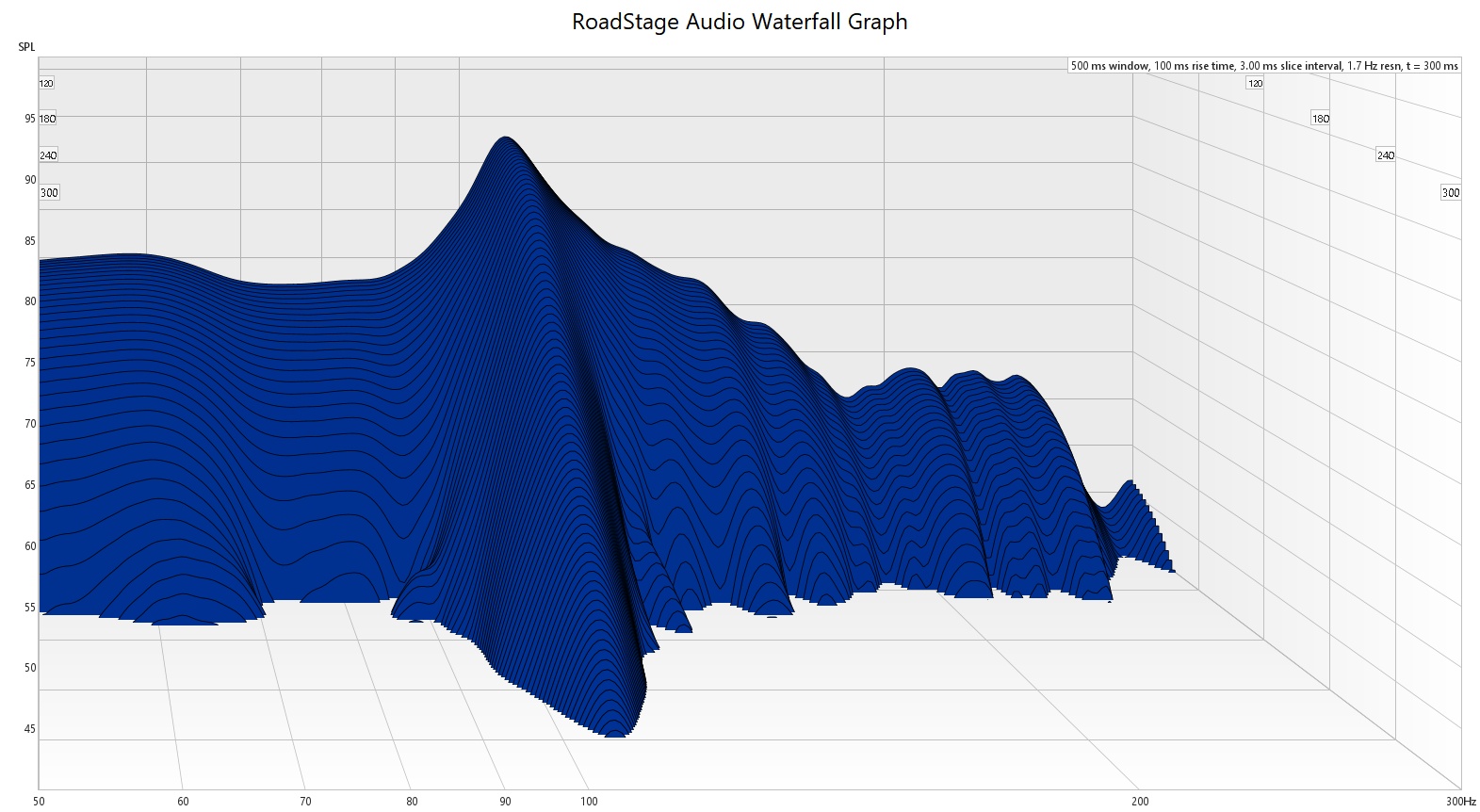

ResoNix vs. Roadstage 3-in-1 Waterfall Graph.

vs.
Second Skin Damplifier Pro
Resonance Reduction
(25% Coverage of Panel)
17 dB
11.5 dB
Price to Performance Equivalent*

$8.50
vs.
Second Skin Damplifier Pro
$27.61
Second Skin Damplifier Pro Sound Deadener Performance
Up next is Second Skin Damplifier Pro. This is regarded as one of the better CLD’s on the market, and they have a very strong marketing push claiming so. Since we know marketing means squat when it actually comes time to using a product, let’s see what the data says. According to the original testing graph, we have a resonance peak reduced from 106.5dB to 95.5dB, an 11dB reduction. In the new testing, we have the same 11db resonance reduction results. This is among some of the better products, but definitely not the best. Let’s compare to ResoNix to see what value you get. ResoNix CLD Squares reduce 17dB of the test panel’s resonance, a 6dB difference vs. the Second Skin Damplifier Pro. This 6dB difference equates to ResoNix being 4x as effective per given amount than the Second Skin Damplifier Pro.
ResoNix vs. Second Skin Damplifier Test 1 Results.
You can get Second Skin Damplifier Pro for $7.67 per square foot if you order their 36sq foot foot bulk pack, similar to our 40 Square Foot pack of ResoNix CLD Squares. Second Skin Damplifier Pro price to performance ratio comes out to $30.68 vs. ResoNix $8.50. And again, you would still need to go through the work of applying, in theory, 4x the amount to get the same result. While I am happy that they are one of the only other American made products out there, this is not a good value.
ResoNix vs. Second Skin Damplifier Test 2 Results.
Second Skin Damplifier Pro Sound Deadener Performance vs Other Popular Brands
Second Skin Damplifier Pro sound deadener demonstrates varied performance when compared to other popular sound deadening products. It is less effective than ResoNix CLD Squares, which reduced resonance by an additional 6db, making ResoNix 4 times better. However, Second Skin Damplifier Pro outperforms Dynamat Extreme, reducing resonance by a further 3.5db, making it 2.25 times more effective. Against Kilmat 80mil, it is significantly more effective, with a 4.25db additional reduction in resonance, translating to 2.7 times better performance. When compared to Soundskins 3-in-1 sound deadener, Second Skin Damplifier Pro is more effective, reducing resonance by an additional 2.5db, making it 1.8 times better.


ResoNix vs. Second Skin Damplifier Pro Waterfall Graph.

vs.
Siless 80mil
Resonance Reduction
(25% Coverage of Panel)
17 dB
8.25 dB
Price to Performance Equivalent*

$8.50
vs.
Siless 80mil
$13.95
Siless 80mil Sound Deadener Performance
The last of the bunch that Chris tested was the Siless 80mil and 50mil. These are also becoming very popular options in the car audio, van build-out, and general automotive world, like many of these other products, due to their cheap price. Well, yes it may be cheap, but does it actually get you your moneys worth? Let’s see.
ResoNix vs. Siless 80mil Test Results.
The Siless 80mil reduced the resonance peak of the test panel by 8.25db, which is definitely on the low side of the bunch. This makes the 17db reduction by ResoNix CLD Squares 7.5x more effective. Siless 80mil has a price of $1.86 per square foot. Doing the math to give us is price to performance vs ResoNix, it comes out at $13.95 per square foot. So, while it may be cheap, it is definitely not a good value, and is definitely a very poor performer. Considering this is 80mil thick butyl it makes me wonder how much this product is loaded with fillers, and if the aluminum is even aluminum (some lower end products have used mylar in the past). Who knows, but it is a poor performer.
Siless 80mil Sound Deadener Performance vs Other Popular Brands
Siless 80mil sound deadener demonstrates varying performance levels compared to other popular sound deadening products. It is significantly outperformed by ResoNix CLD Squares, with ResoNix reducing resonance by an additional 8.75db, making it 7.5 times more effective. However, Siless 80mil slightly outperforms Dynamat Extreme, with a 0.25db greater reduction in resonance, making it 1.05 times better. It is less effective than Soundskins, which reduces resonance by 0.75db more, making Soundskins 1.2 times better. Against Kilmat 80mil, Siless 80mil shows better performance, reducing resonance by 1db more, making it 1.25 times more effective.
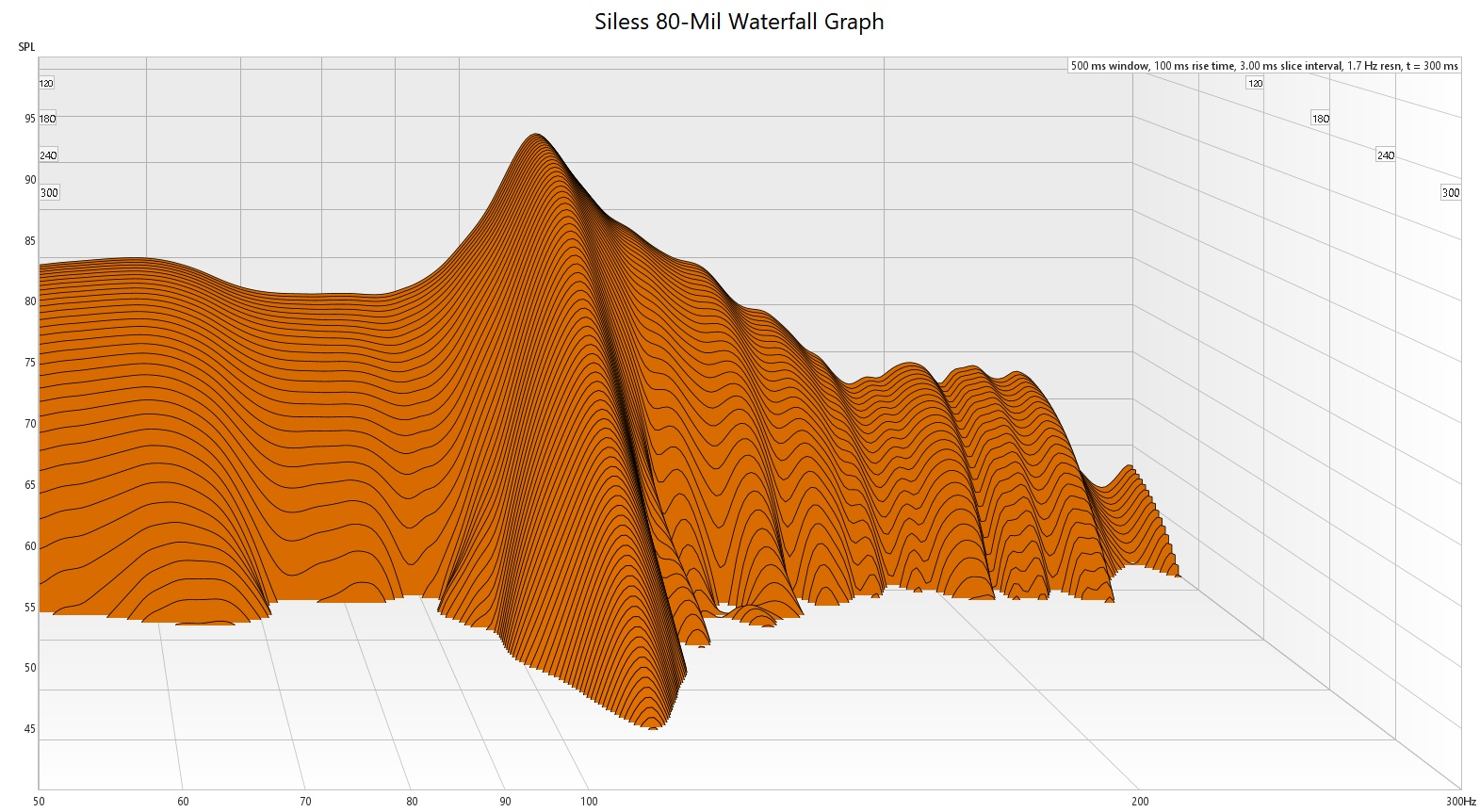

ResoNix vs. Siless 80mil Waterfall Graph.

vs.
Siless 50mil
Resonance Reduction
(25% Coverage of Panel)
17 dB
4.75 dB
Price to Performance Equivalent*

$8.50
vs.
Siless 50mil
$22.61
Siless 50mil Sound Deadener Performance
Up last, and spoiler alert, also the least.. Siless 50mil. Siless, as mentioned has become popular for its cheap price, and the 50mil version is even cheaper than its original counterpart.
ResoNix vs. Siless 50mil Test Results.
Getting into it, Siless 50mil reduced the test panels resonance peak by a mere 4.75db. This is by far the lowest performing product tested to date outside of fatmat and peel-and-seal, which are aslphalt products and Chris hasnt bothered to test on his new rig. With the 4.75 resonance reduction, it makes ResoNix CLD Squares are 17x more effective per given amount of coverage. How does this relate to its price to performance? Well, considering Siless 50mil is $1.33 per square foot, that makes its price to performance equal to $22.61 per square foot in relation to ResoNix CLD Squares $8.50 per square foot. I truly didn’t know a butyl based product could perform this poorly. It again, makes me wonder what it is truly comprised of.
Siless 50mil Sound Deadener Performance vs Other Popular Brands
Siless 50mil sound deadener, the least effective among those tested, shows significantly lower performance compared to other popular brands. ResoNix CLD Squares greatly outperforms it by reducing resonance by an additional 12.25db, making ResoNix 17 times more effective. Dynamat Extreme also performs better than Siless 50mil, with a 3.25db greater reduction in resonance, making it 2.1 times better. Soundskins surpasses Siless 50mil as well, with a 4.25db higher reduction in resonance, making it 2.6 times more effective. Even Kilmat 80mil shows better performance, reducing resonance by 2.5db more, making it 1.8 times more effective than Siless 50mil.
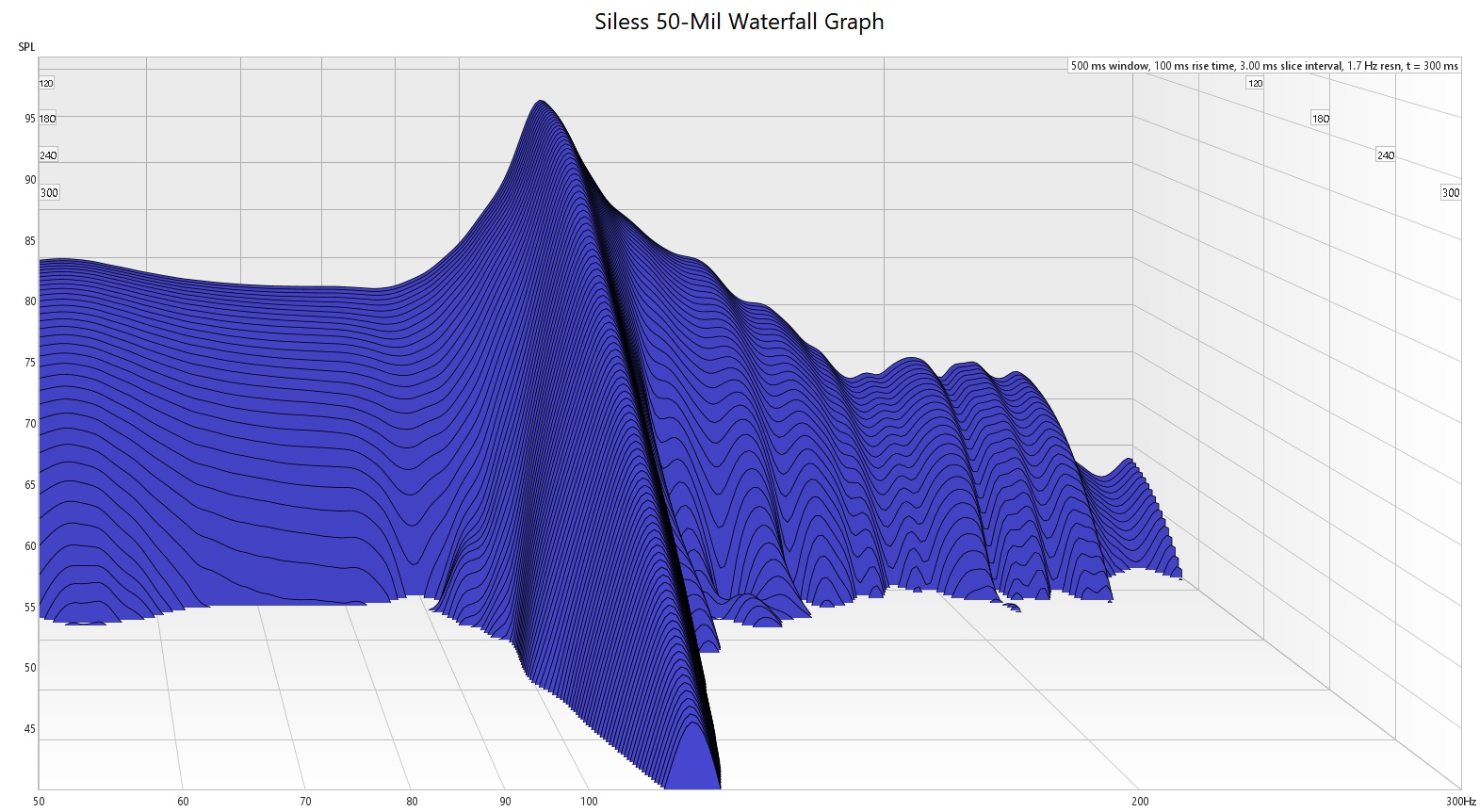

ResoNix vs. Siless 50mil Waterfall Graph.

vs.
Smartmat
Resonance Reduction
(25% Coverage of Panel)
17 dB
9.75 dB
Price to Performance Equivalent*

$8.50
vs.
Smartmat
$10.62
Smartmat 90mil Sound Deadener Performance
Another random constrained layer damper from Amazon it seems, Smartmat 90mil seems really fancy looking and looks like a good budget to those who arent as educated on the subject.
ResoNix vs. Smartmat 90-mil Test Results.
It turns out its resonance control performance is average at best. Smartmat reduced the test panels resonance peak by 9.75db, which makes the 17db reduction by ResoNix CLD Squares 5.5x as effective. Smartmat 90mil comes in at $1.93 per square foot, which gives it a price to performance equivalence of $10.62 vs. ResoNix CLD Squares $8.50. This is another product that I am very curious to see how it does in long-term heat testing.
Smartmat 90mil Sound Deadener Performance vs Other Popular Brands
Siless 50mil sound deadener, the least effective among those tested, shows significantly lower performance compared to other popular brands. ResoNix CLD Squares greatly outperforms it by reducing resonance by an additional 12.25db, making ResoNix 17 times more effective. Dynamat Extreme also performs better than Siless 50mil, with a 3.25db greater reduction in resonance, making it 2.1 times better. Soundskins surpasses Siless 50mil as well, with a 4.25db higher reduction in resonance, making it 2.6 times more effective. Even Kilmat 80mil shows better performance, reducing resonance by 2.5db more, making it 1.8 times more effective than Siless 50mil.
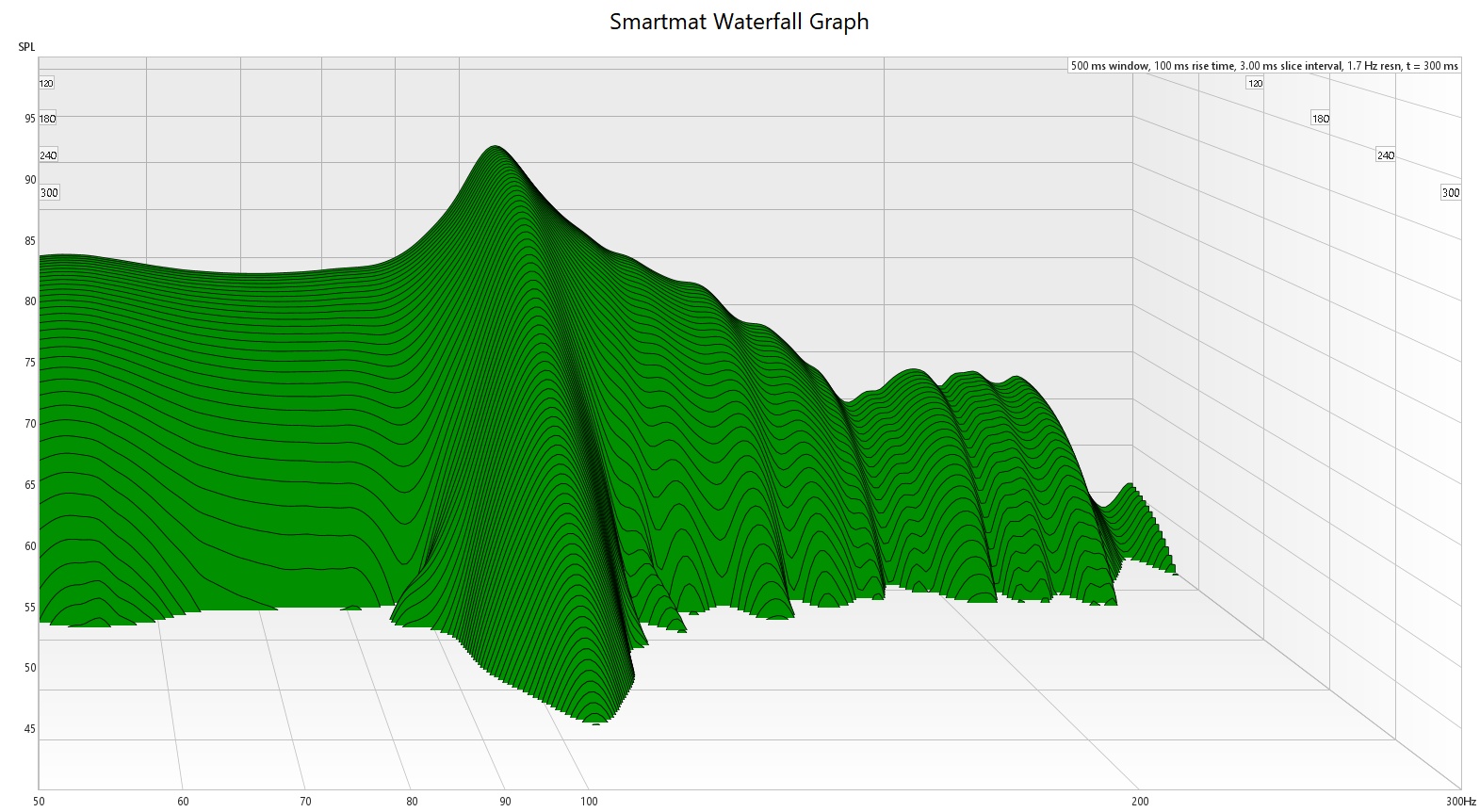

ResoNix vs. Smartmat 90-mil Waterfall Graph.

vs.
Noico
Resonance Reduction
(25% Coverage of Panel)
17 dB
9.5 dB
Price to Performance Equivalent*

$8.50
vs.
Noico
$34.52

vs.
Noico with Noico Roller
Resonance Reduction
(25% Coverage of Panel)
17 dB
9.75 dB
Price to Performance Equivalent*

$8.50
vs.
Noico with Noico Roller
$32.08

vs.
Noico with Aggressive Roller
Resonance Reduction
(25% Coverage of Panel)
17 dB
7.5 dB
Price to Performance Equivalent*

$8.50
vs.
Noico with Aggressive Roller
$54.99
Noico Sound Deadener Performance
ResoNix vs. Noico Test 1 Results.
ResoNix vs. Noico Test 2 Results.
Noico Sound Deadener Performance vs Other Popular Brands
Noico Sound Deadener shows mixed performance compared to other popular sound deadeners. It is significantly less effective than ResoNix CLD Squares, with ResoNix performing 5.65 times better. However, Noico outperforms Kilmat 80mil by reducing resonance by an additional 2.25db, making it 1.7 times better. It also slightly exceeds Soundskins 3-in-1 by reducing resonance by 0.5db more, translating to a 1.15 times better performance. Against Dynamat Extreme and the similar performing Soundskins sound deadener, Noico has a slight edge with 1.5db more reduction in resonance, making it 1.4 times better. However, while Dynamat Extreme is better known than Noico for its reliability in hot climates, as there are reports of Noico failing under high temperatures.
